Woodpeckers are an incredibly diverse species of bird, found in habitats all over the world. They are renowned for their unique, rhythmic drumming, which is used for communication, foraging for food, and for excavating nesting sites.
Woodpeckers have adapted to their habitats in impressive ways, from their specialized tongues to their strong beaks and feet.
They are also incredibly resilient and have been known to survive in areas affected by deforestation and other human activities.
Despite their small size, woodpeckers are a powerful symbol of the resilience of nature and its ability to adapt to changing environmental conditions.
1. Downy Woodpecker
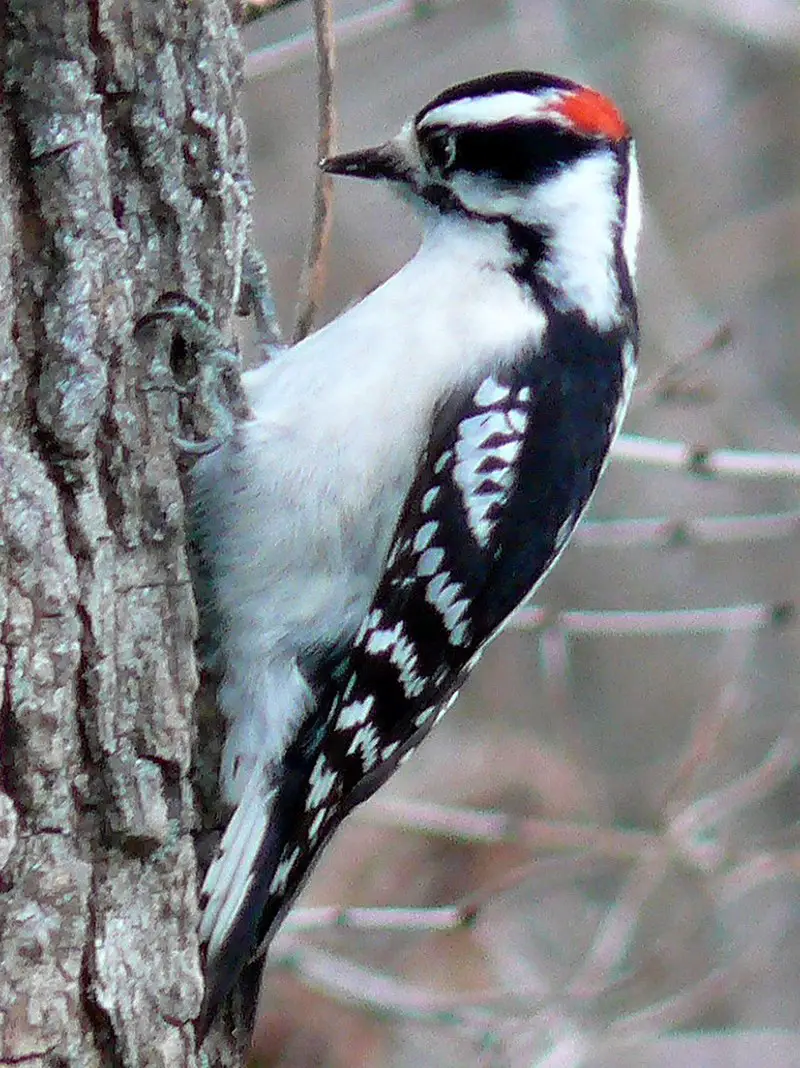
The downy woodpecker is a small species of woodpecker found in North America. Growing up to 7 inches long, it can be identified by its white belly and spotted wings.
It inhabits forests throughout the United States and Canada, with the exception of deserts in the southwest and northern tundra.
This bird nests in tree cavities and feeds mostly on insects but will supplement its diet with fruit or nuts when available.
The Downy Woodpecker has an unmistakable call that sounds like a loud ‘pik-er’, similar to other members of its family such as the Hairy Woodpecker.Scientific classification:
| Kingdom | Animalia |
| Phylum | Chordata |
| Class | Aves |
| Order | Piciformes |
| Family | Picidae |
| Genus | Dryobates |
| Species | D. pubescens |
2. Red-Headed Woodpecker
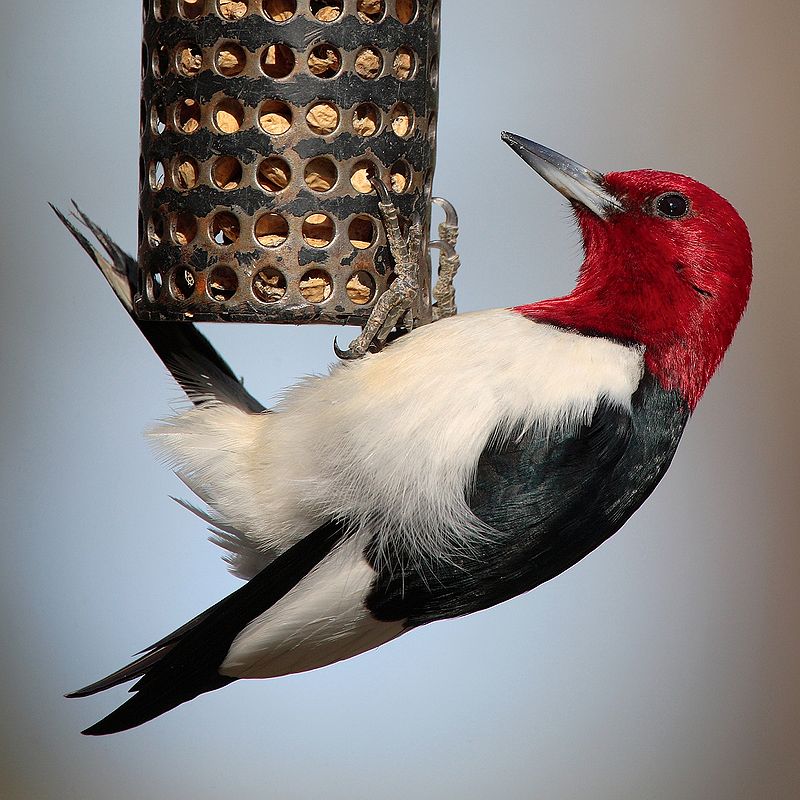
The red-headed woodpecker is a mid-sized bird found in temperate North America. It has striking plumage, with its head and neck being bright red while the rest of its body is primarily black and white.
Its wings are rounder than other similar species, allowing it to maneuver through tight spaces easily when searching for food or shelter.
The breeding habitat of this bird consists mainly of open fields across Canada and the east-central United States.
Despite facing threats such as deforestation, urbanization, predation from larger birds, collisions with windows or cars due to their inquisitive nature.
These birds remain listed on IUCN’s Red List as least concern thanks largely in part to conservation efforts by local governments and organizations dedicated to protecting wildlife habitats.Scientific classification:
| Kingdom | Animalia |
| Phylum | Chordata |
| Class | Aves |
| Order | Piciformes |
| Family | Picidae |
| Genus | Melanerpes |
| Species | M. erythrocephalus |
3. Pileated Woodpecker
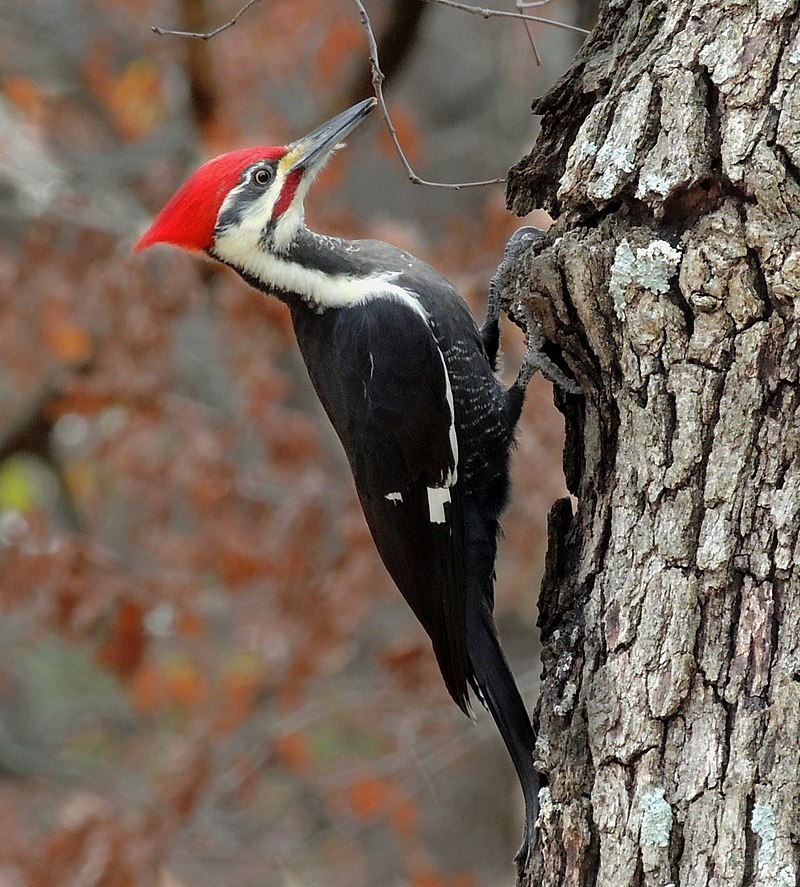
The pileated woodpecker is a large, majestic bird native to North America.
Its striking black plumage and red crest make it an unmistakeable sight in the forest canopy of deciduous forests across eastern North America, Great Lakes region, Canada’s boreal forests, and parts of the Pacific Coast.
It is one of the largest woodpeckers in North America: larger than any other confirmed species except for perhaps its relative; the ivory-billed woodpecker.
Insectivorous by nature, this stunning creature can be seen pecking away at tree trunks searching for food or making nest cavities – all with remarkable skill.
The pileated woodpecker truly stands out as a symbol of beauty and resilience amongst our avian wildlife.Scientific classification:
| Kingdom | Animalia |
| Phylum | Chordata |
| Class | Aves |
| Order | Piciformes |
| Family | Picidae |
| Genus | Dryocopus |
| Species | D. pileatus |
4. Red-Bellied Woodpecker
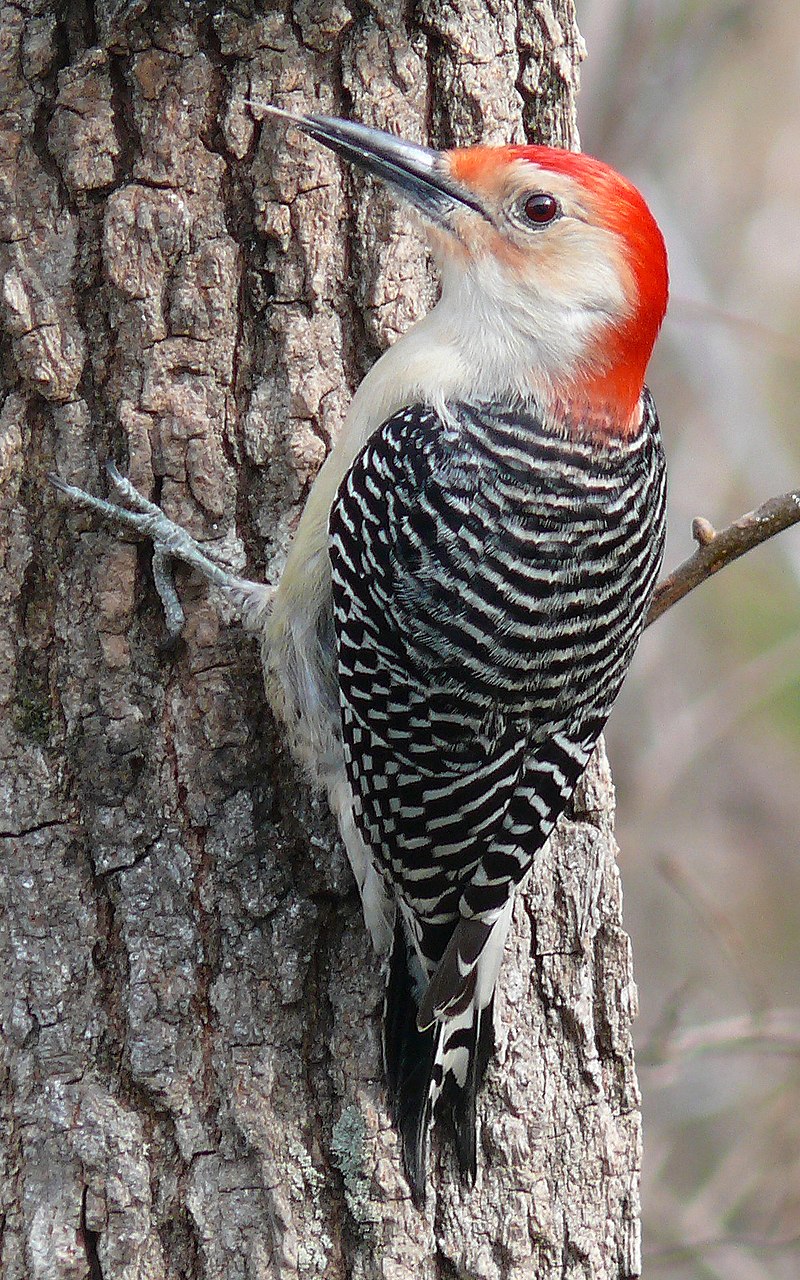
The Red-bellied woodpecker is a beautiful bird with an orange-red crown and nape. It breeds mainly in the eastern United States, ranging from Florida to Canada.
This medium-sized woodpecker of the family Picidae has black wings, white stripes on its back and tail feathers that are barred with black.
Its underside is mostly pale yellow or white but it also features some red coloration around its neck area.
Despite this subtle red hue, it should not be mistaken for the entirely red head and neck belonging to the Red-headed woodpecker of the same genus Melanerpes carolinus.
The Red bellied Woodpeckers diet consists primarily of insects such as ants, beetles and grasshoppers along with nuts fruits berries and tree sap which they will feed upon during different times throughout their life cycle.Scientific classification:
| Kingdom | Animalia |
| Phylum | Chordata |
| Class | Aves |
| Order | Piciformes |
| Family | Picidae |
| Genus | Melanerpes |
| Species | M. carolinus |
5. Yellow-Bellied Sapsucker
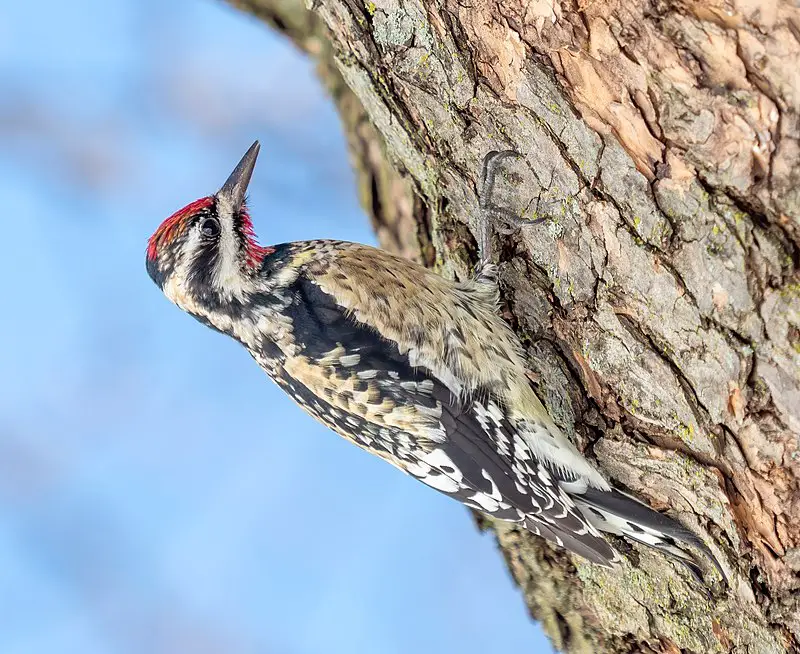
The Yellow-bellied Sapsucker is a medium sized woodpecker that can be found in Canada and the northeastern United States.
It was first described by English naturalist Mark Catesby who illustrated it with hand coloured plates for his book The Natural History of Carolina, Florida and the Bahama Islands during 1729 -1732.
This beautiful bird has white stripes on its black head which contrast against its yellow throat, breast and belly making it stand out from other birds. Its wings are barred with red patches adding to their beauty.
They also have white streaks on their sides along with bold spots at their back giving them an unique look among others.Scientific classification:
| Kingdom | Animalia |
| Phylum | Chordata |
| Class | Aves |
| Order | Piciformes |
| Family | Picidae |
| Genus | Sphyrapicus |
| Species | S. varius |
Also Featured In: Long Island Birds You Should Know, Black And White Birds You Don’t Know About
6. Great Spotted Woodpecker
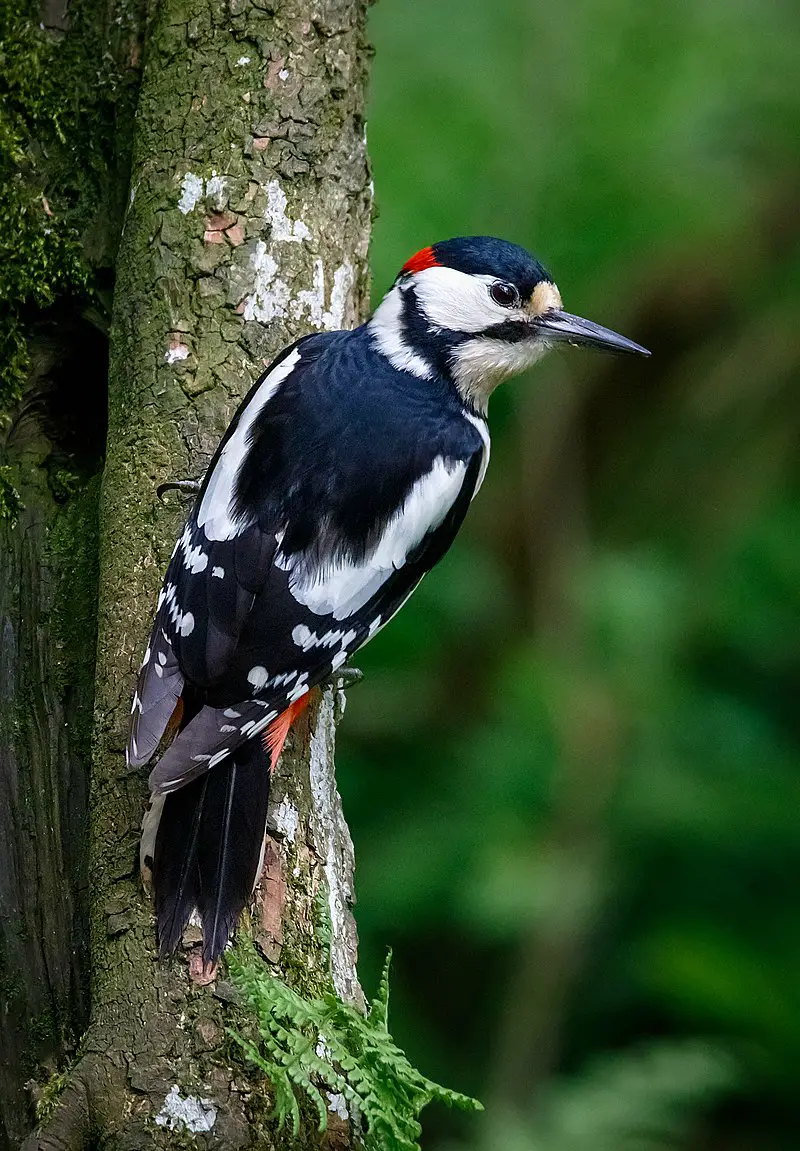
The Great Spotted Woodpecker is a fascinating bird. It has black and white feathers, with red patches on its lower belly and head or neck depending on whether it’s male or young.
This species inhabits most of the Palearctic region as well as some parts of North Africa.
For much of its range, it remains in one place all year round but may migrate if food sources become limited further north.
Its diet consists mainly of insects found under tree bark along with small amounts of seeds and fruit when available.
Despite being quite vocal they are hard to spot due to their camouflaged feathers which helps protect them from predators like cats and birds-of-prey.Scientific classification:
| Kingdom | Animalia |
| Phylum | Chordata |
| Class | Aves |
| Order | Piciformes |
| Family | Picidae |
| Genus | Dendrocopos |
| Species | D. major |
7. Lewis’s Woodpecker
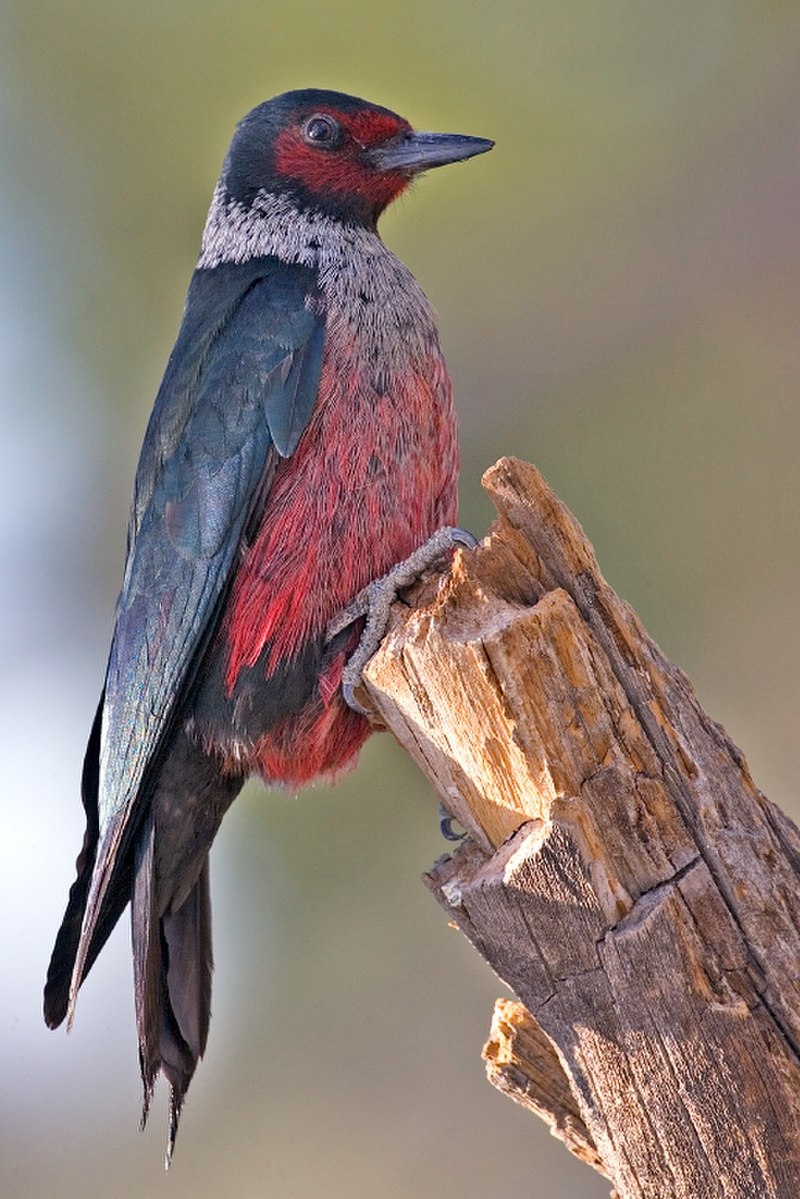
Lewis’s woodpecker is a large species of North American bird, discovered and named after Meriwether Lewis by the ornithologist Alexander Wilson.
Its body measures 18-23 cm in length, with a wingspan ranging from 25 to 30 cm.
It has dark plumage on its back and head that transitions into lighter brown feathers on its chest, belly and tail.
The male bird has bright red patches along the sides of his neck as well as at the base of his bill while females have pinkish or yellow tones instead.
This species primarily feeds on insects such ants which it finds underneath bark or near dead trees where they live their solitary lives except during mating season when pairs form temporary bonds for breeding purposes before going off alone again afterwards.Scientific classification:
| Kingdom | Animalia |
| Phylum | Chordata |
| Class | Aves |
| Order | Piciformes |
| Family | Picidae |
| Genus | Melanerpes |
| Species | M. lewis |
Also Featured In: Birds that Live in the Grand Canyon National Park, Birds that Live in Manitoba
8. Red-Cockaded Woodpecker
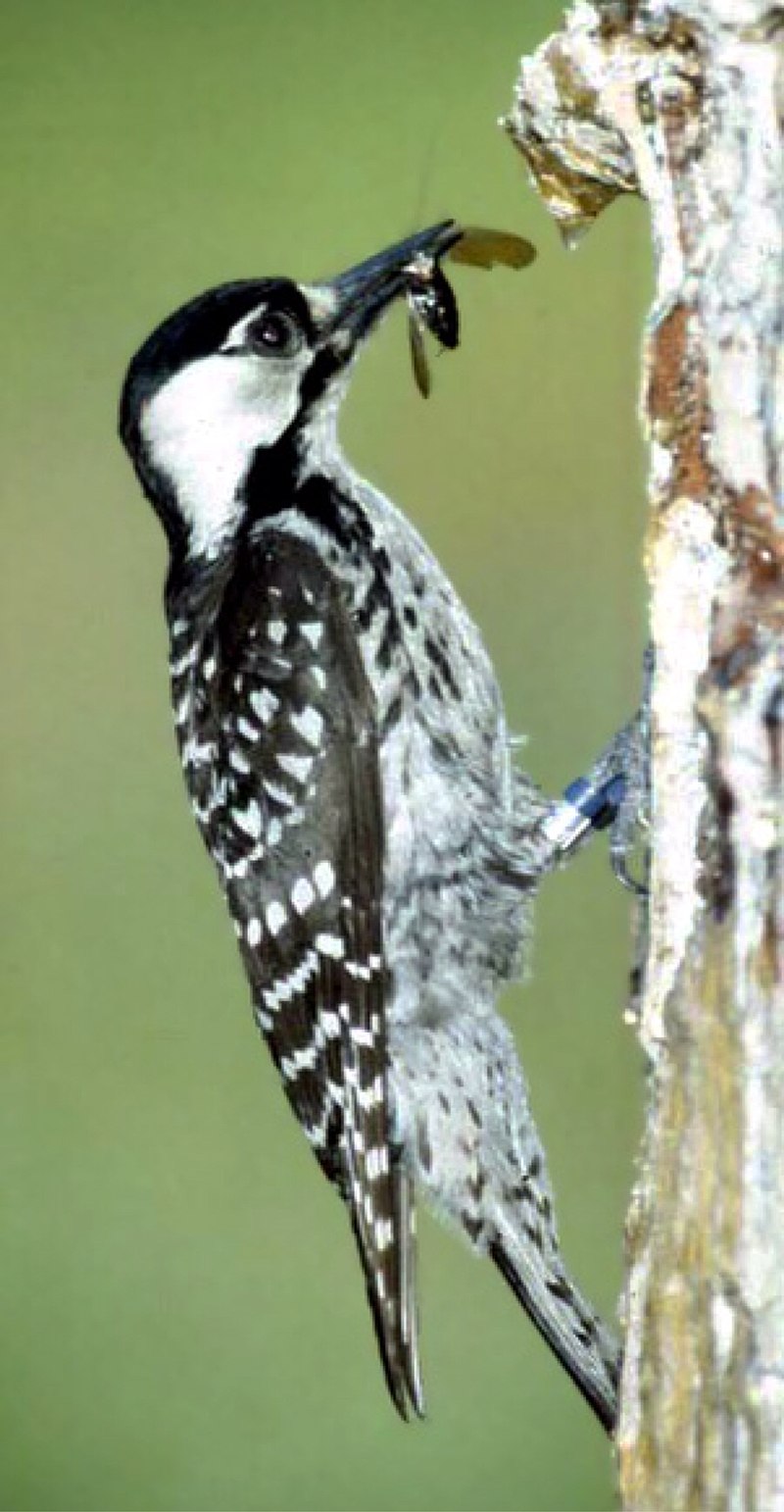
The Red-cockaded Woodpecker is a species of woodpecker endemic to the southeastern United States.
It stands out amongst its peers due to its unique physical features and size – it measures between 18–23 cm in length, with wings that span 34–41 cm across.
This small-to-mid sized bird also has an interesting color pattern; it has white barring on black feathers while wearing a red cockade (or patch) near the back of its head.
Its diet consists mostly of insects found on tree bark such as beetles, ants and caterpillars, but they have been known to eat fruits like wild plums during certain times of year too.
The Red-cockaded Woodpecker is protected by conservation efforts throughout their range as this species faces threats from habitat destruction and fragmentation caused by human activities.Scientific classification:
| Kingdom | Animalia |
| Phylum | Chordata |
| Class | Aves |
| Order | Piciformes |
| Family | Picidae |
| Genus | Leuconotopicus |
| Species | L. borealis |
Also Featured In: Red Birds of North Carolina,
9. Black-Backed Woodpecker

The Black-backed Woodpecker (Picoides arcticus) is a medium sized bird found in the forests of North America. It has black upperparts and white underparts, with three toes on each foot.
The species was first described by English naturalist William John Swainson in 1832 from a specimen collected near the source of the Athabasca River on its eastern slopes. Its diet consists mainly of insects, larvae, and carrion.
They are often seen searching for food while clinging to tree trunks or branches like other woodpeckers do; they also excavate cavities in dead trees which provide them shelter during cold weathers as well as nesting sites for their young ones.
These birds have adapted to survive even at temperatures below zero degrees Celsius due to their thick feather coat which keeps them warm despite extreme weather conditions that occur in higher elevation areas where these birds typically reside.Scientific classification:
| Kingdom | Animalia |
| Phylum | Chordata |
| Class | Aves |
| Order | Piciformes |
| Family | Picidae |
| Genus | Picoides |
| Species | P. arcticus |
Also Featured In: Common Winter Birds of New Brunswick, Small Birds Of Illinois
10. Acorn Woodpecker
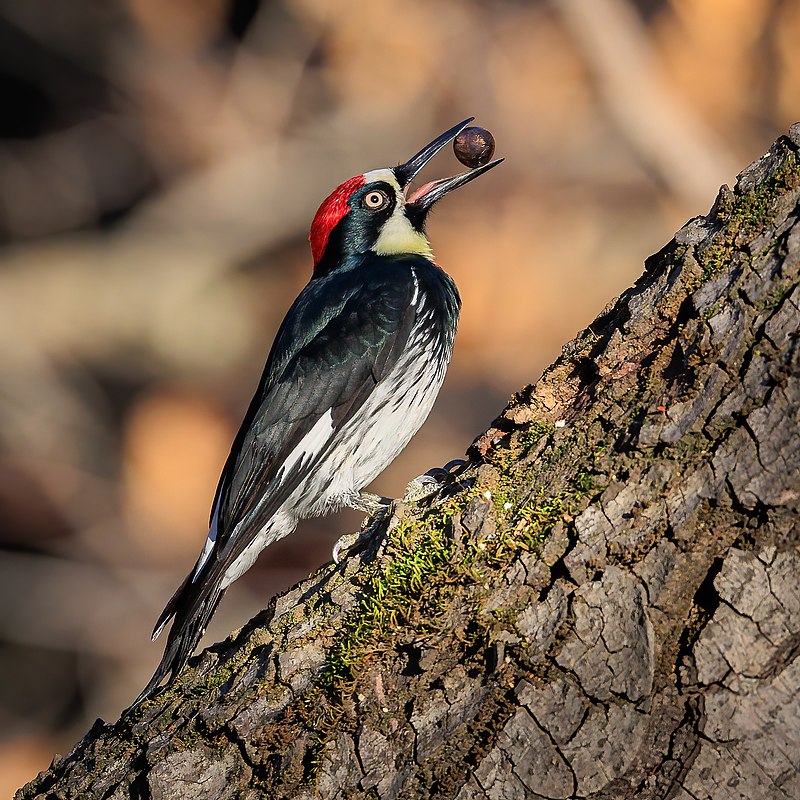
The Acorn woodpecker is a medium-sized bird with an average weight of 85 grams and 8.3 inches in length. It was first described by the English naturalist William John Swainson from a specimen collected in Mexico, back in 1827.
Its scientific name, Melanerpes formicivorus, combines Latin words meaning “ant” and “-vorous”.
This species has distinct black plumage all over its body except for some white patches on their wings and tail feathers which can be seen when flying or perched atop trees.
They are known to store acorns inside tree crevices as well as within bark cracks – often using them during lean times.
The acorn woodpecker is also socially active; they live together with other birds of their kind in groups called ‘granaries’. Their chirps are loud enough that they can easily be heard from afar.Scientific classification:
| Kingdom | Animalia |
| Phylum | Chordata |
| Class | Aves |
| Order | Piciformes |
| Family | Picidae |
| Genus | Melanerpes |
| Species | M. formicivorus |
11. Ivory-Billed Woodpecker
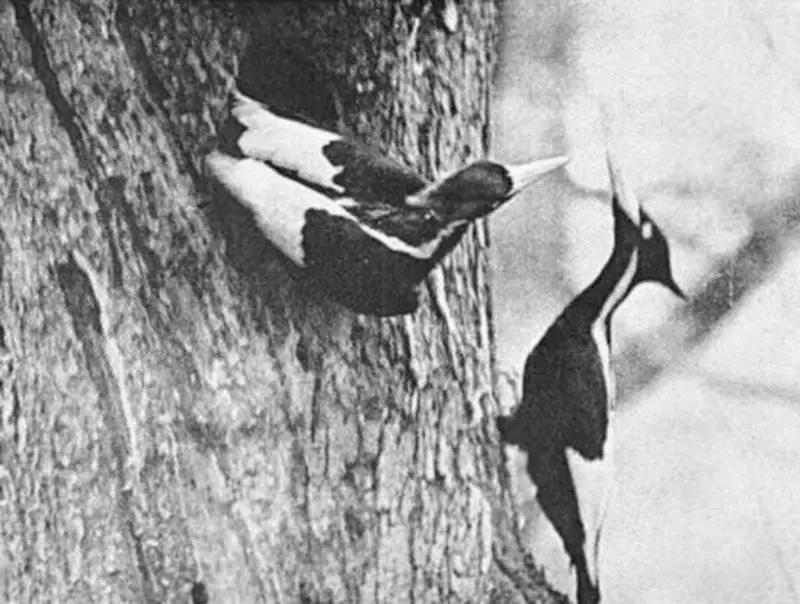
The Ivory-billed woodpecker is a beautiful bird native to the Southern United States and Cuba.
Sadly, due to habitat destruction and hunting, its numbers have greatly decreased so much that it has been classified as critically endangered by the International Union for Conservation of Nature (IUCN).
It typically lives in bottomland hardwood forests or temperate coniferous forests. This species is notable for having very large bills which are ivory colored on top with black underneath – hence their name.
They can be up to 20 inches long and weigh around 10 ounces when fully grown. These birds mainly feed on insects such as ants and beetles but will sometimes eat fruits too.
Despite our best efforts, this stunning species may soon vanish forever unless we take drastic action now.Scientific classification:
| Kingdom | Animalia |
| Phylum | Chordata |
| Class | Aves |
| Order | Piciformes |
| Family | Picidae |
| Genus | Campephilus |
| Species | C. principalis |
12. American Three-Toed Woodpecker
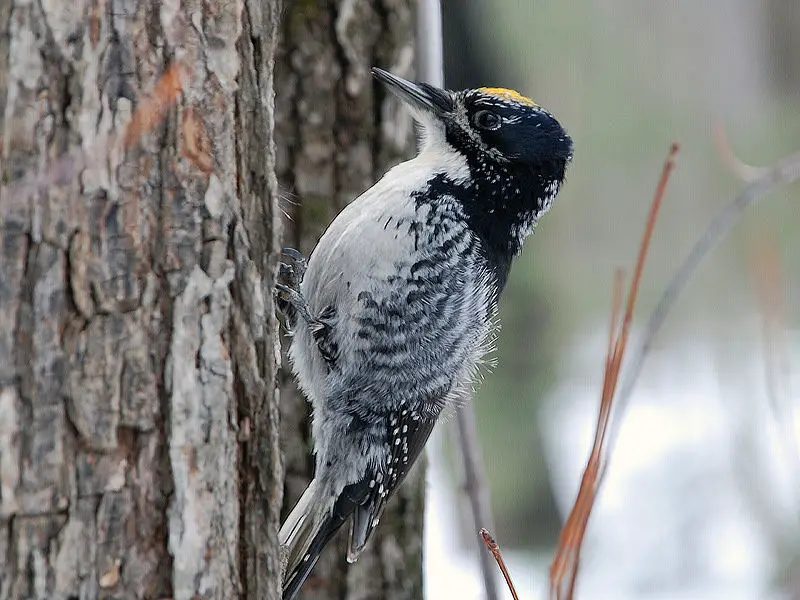
The American three-toed woodpecker is a medium sized member of the Picidae family, native to North America.
It measures 8.3 inches in length and has a wingspan around 15 inches wide; it typically weighs 1.9 ounces.
This species closely resembles its black-backed relation, which also has three toes on each foot.
The maximum lifespan for this bird in its natural habitat is 6 years old – relatively short compared to other birds of similar size – but they are still highly valued as important members of their ecosystem.
They help control insect populations while providing an interesting display when observed up close or from afar.Scientific classification:
| Kingdom | Animalia |
| Phylum | Chordata |
| Class | Aves |
| Order | Piciformes |
| Family | Picidae |
| Genus | Picoides |
| Species | P. dorsalis |
Also Featured In: Birds that Found in the Yellowstone ,
13. Ladder-Backed Woodpecker
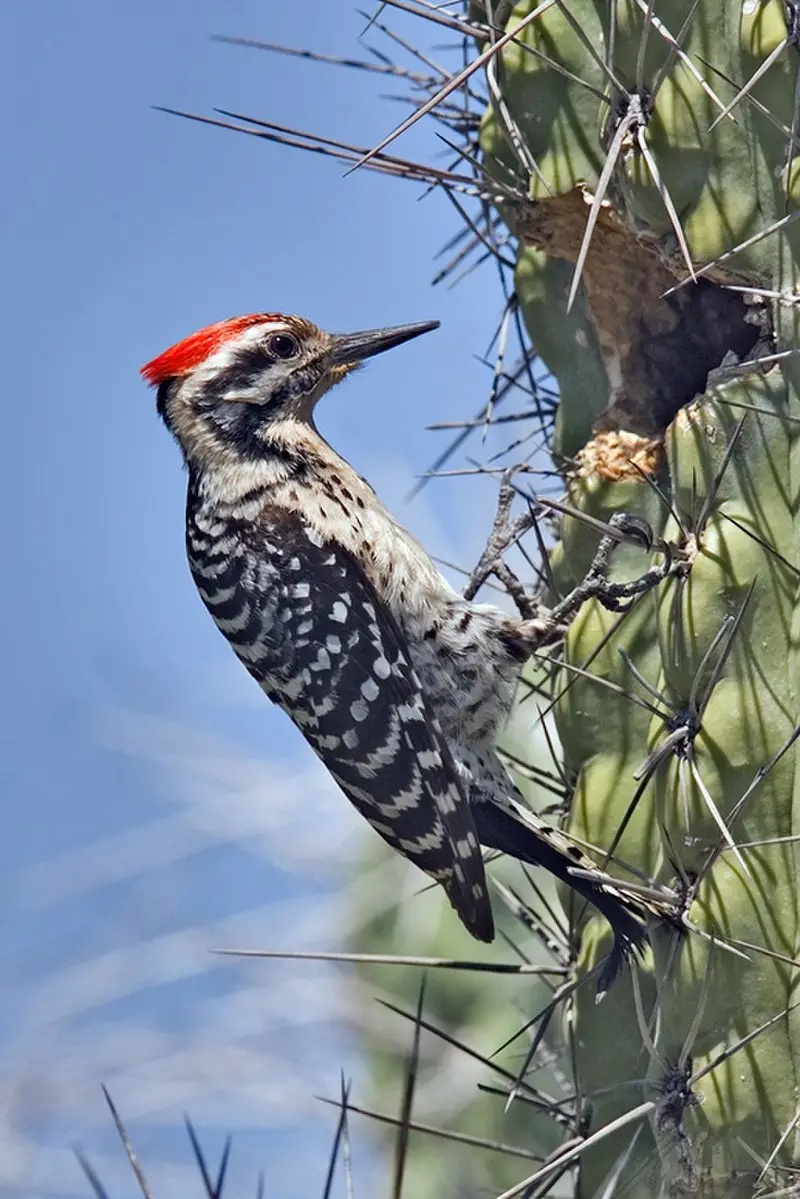
The Ladder-backed Woodpecker is a small black and white bird native to North America.
At about 16.5-19 cm in length, it has a characteristic barred pattern on its back resembling the rungs of a ladder, as well as speckled black rump and cream colored underparts on its breast and flanks.
These birds can be found inhabiting woodlands across their range, where they feed mostly on insects that they find by drilling into trees or hunting from exposed branches.
Their call consists of short chirps repeated every few seconds with an occasional longer trill thrown in for good measure.
They are also known to use twigs or other objects to probe crevices while searching for food – making them quite resourceful hunters indeed.Scientific classification:
| Kingdom | Animalia |
| Phylum | Chordata |
| Class | Aves |
| Order | Piciformes |
| Family | Picidae |
| Genus | Dryobates |
| Species | D. scalaris |
Also Featured In: Central Texas Birds, Birds You’ll Find in South Texas
14. White-Headed Woodpecker
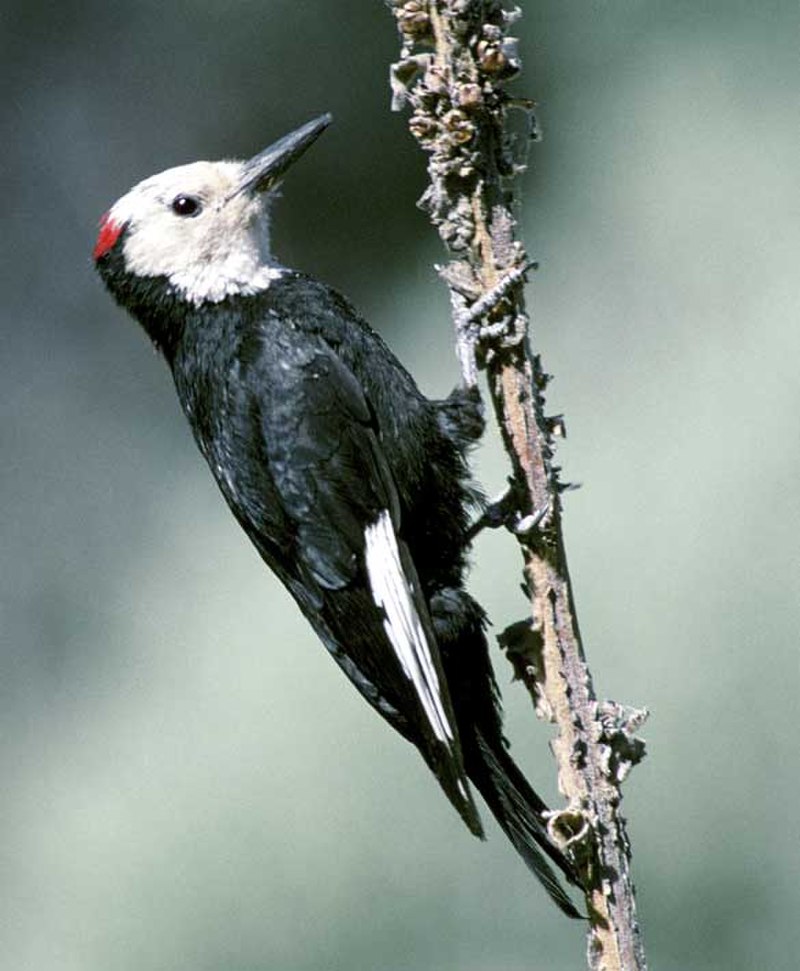
The white-headed woodpecker is a beautiful, non-migratory bird native to the pine forests of western North America.
It has a black body that measures around 20 cm in length and a distinctively white head with crescent shaped primary feathers.
The male also features an attractive red spot at the back of its head as well.
This range stretches from British Columbia down through California, Arizona and New Mexico; they typically inhabit elevation ranging between 900–3000 m above sea level but can be found up to 4200 m on occasion.
They are omnivorous birds that feed mainly on insects such as ants and beetles, although they will occasionally supplement their diet with fruits or nuts when available.
All in all, this truly remarkable species offers much for us to admire about it.Scientific classification:
| Kingdom | Animalia |
| Phylum | Chordata |
| Class | Aves |
| Order | Piciformes |
| Family | Picidae |
| Genus | Leuconotopicus |
| Species | L. albolarvatus |
Also Featured In: Most Common Lake Birds, Lake Tahoe Birds
15. Golden-Fronted Woodpecker
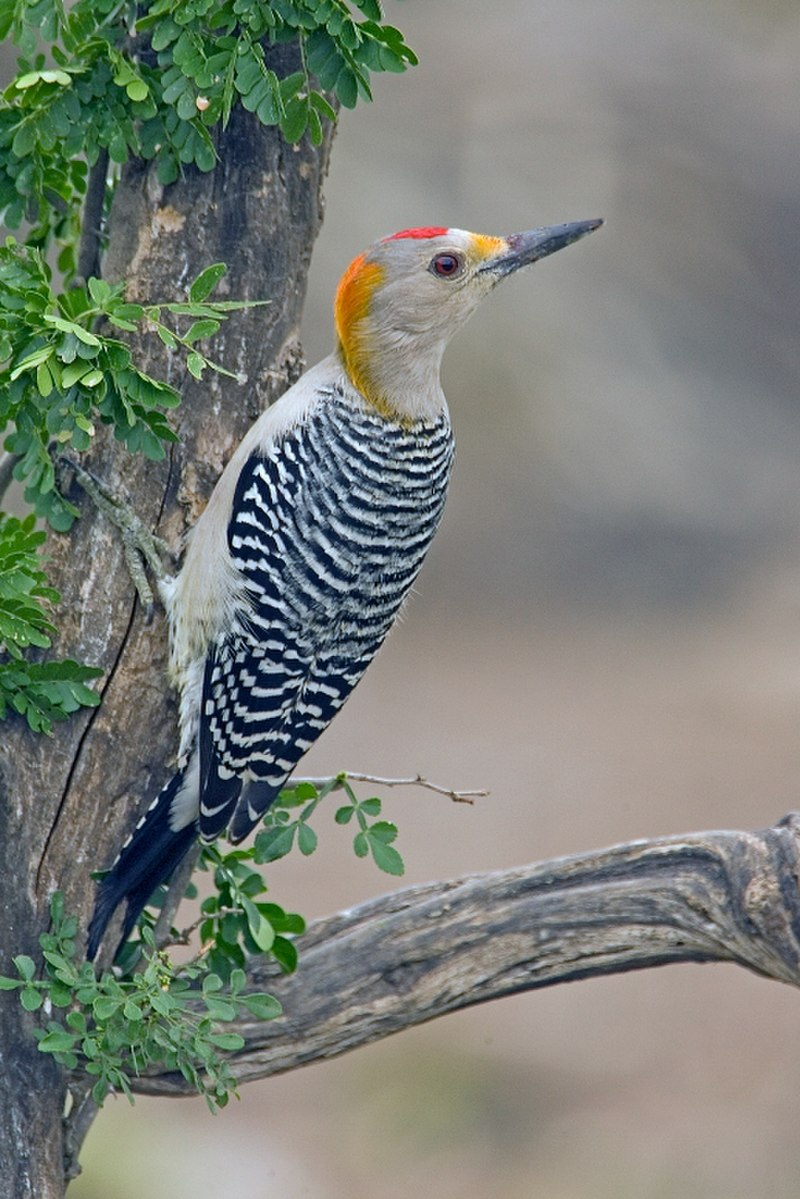
The golden-fronted woodpecker is an attractive species that inhabits mesquite, riparian woodlands and tropical rainforests across the southern United States, Mexico, Belize Guatemala El Salvador Honduras and northern Nicaragua.
It has a unique appearance with its yellow forehead patch contrasting against its grey back feathers.
These birds eat insects as well as fruits of many trees including cactus fruit in some areas.
They are known to make nests in cavities they excavate from dead or dying trees or utility poles which helps disperse essential nutrients into the ecosystem.
Their loud calls can be heard during breeding season providing bird watchers with a memorable experience.Scientific classification:
| Kingdom | Animalia |
| Phylum | Chordata |
| Class | Aves |
| Order | Piciformes |
| Family | Picidae |
| Genus | Melanerpes |
| Species | M. aurifrons |
16. Nuttall’s Woodpecker
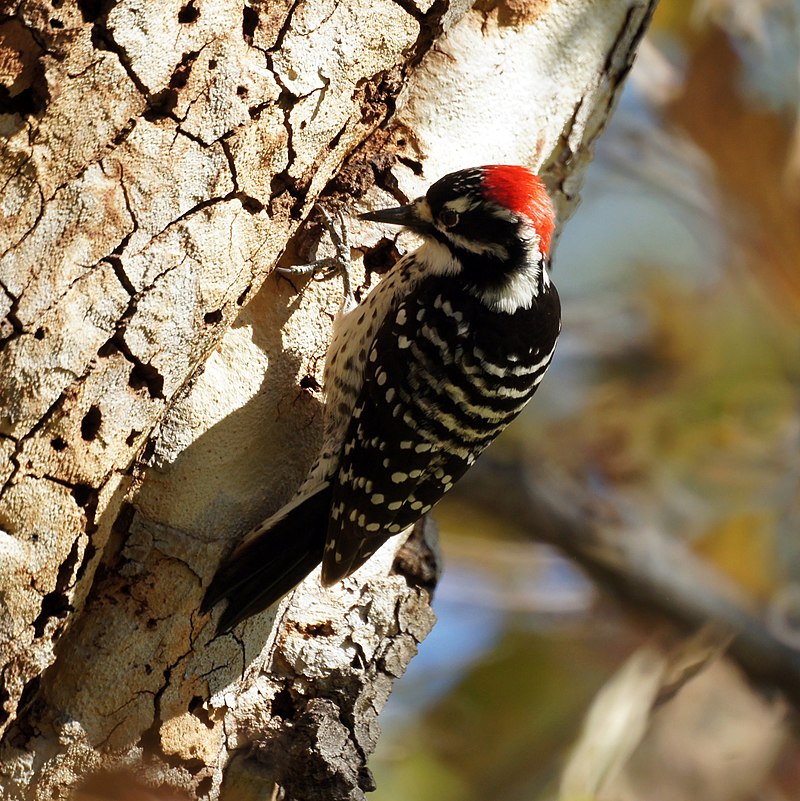
Nuttall’s woodpecker is a species of woodpecker named after naturalist Thomas Nuttall in 1843.
It is found mainly in oak woodlands of California and resembles the ladder-backed woodpecker genetically and physically.
The bird has black wings and tail feathers with white barring, as well as a white ventral surface decorated by small black spots.
They are quite distinct from other species due to their unique colouring; they have been known to hybridize successfully with red-naped sapsuckers when their habitats overlap.
While not considered threatened or endangered, these birds must be monitored closely to ensure that populations remain healthy across their range.Scientific classification:
| Kingdom | Animalia |
| Phylum | Chordata |
| Class | Aves |
| Order | Piciformes |
| Family | Picidae |
| Genus | Dryobates |
| Species | D. nuttallii |
Also Featured In: Birds Live Near San Diego, Birds that Live in San Francisco Bay Area
17. Gila Woodpecker
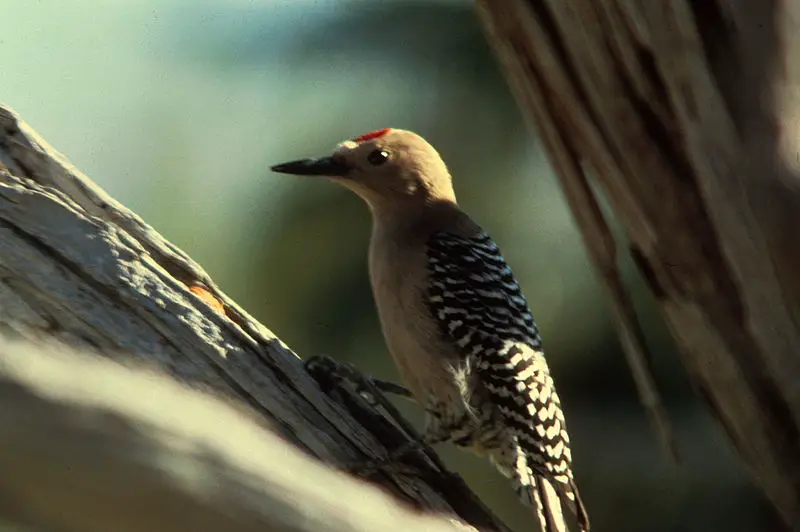
The Gila woodpecker is a medium-sized bird found in the desert regions of the southwestern United States and western Mexico.
It has a unique coloration, featuring black and white zebra-like stripes on its back, wings, and tail feathers.
Its neck, throat belly and head are greyish tan in color with small red or yellow spots on its nape.
They feed mainly on insects but have been known to eat berries when available during winter months.
These birds are social creatures that often nest together in large colonies to increase their chances of survival against predators such as hawks or owls.
The Gila woodpecker plays an important role in maintaining healthy ecosystems by eating destructive beetles while also spreading seeds from cacti they consume throughout the year.Scientific classification:
| Kingdom | Animalia |
| Phylum | Chordata |
| Class | Aves |
| Order | Piciformes |
| Family | Picidae |
| Genus | Melanerpes |
| Species | M. uropygialis |
Also Featured In: Phoenix Birds You Should Know, Birds that Live in the Deserts
18. Red-Naped Sapsucker
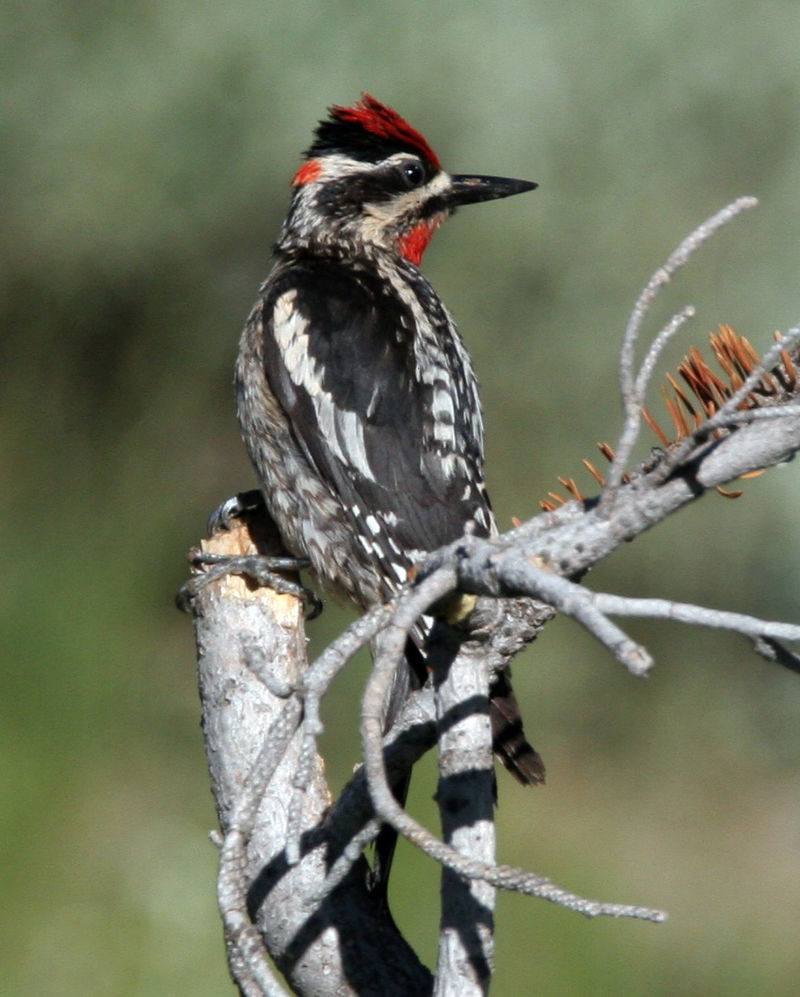
The Red-naped Sapsucker is a medium sized woodpecker native to North America. It was initially thought to be a subspecies of the yellow-bellied sapsucker, but it has since been identified as its own species.
This bird belongs in the genus Sphyrapicus, and does not have any known subspecies. Its distinct red head patch makes this species easy to identify among other birds of its kind.
It can usually be found near conifers or deciduous trees that contain sap wells drilled by these birds for their food source – mainly insects and tree sap.
These birds are also known to eat fruits, berries and nuts during winter months when bug populations decrease significantly.
The Red-naped Sapsucker is an important part of many ecosystems across North America due their unique diet habits which provide essential nutrients needed for plant growth and health; making them a valuable asset in preserving forests everywhere.Scientific classification:
| Kingdom | Animalia |
| Phylum | Chordata |
| Class | Aves |
| Order | Piciformes |
| Family | Picidae |
| Genus | Sphyrapicus |
| Species | S. nuchalis |
Also Featured In: Common Birds of Antelope Island State Park, Antelope Island Birds You Didn’t Know
19. Williamson’s Sapsucker
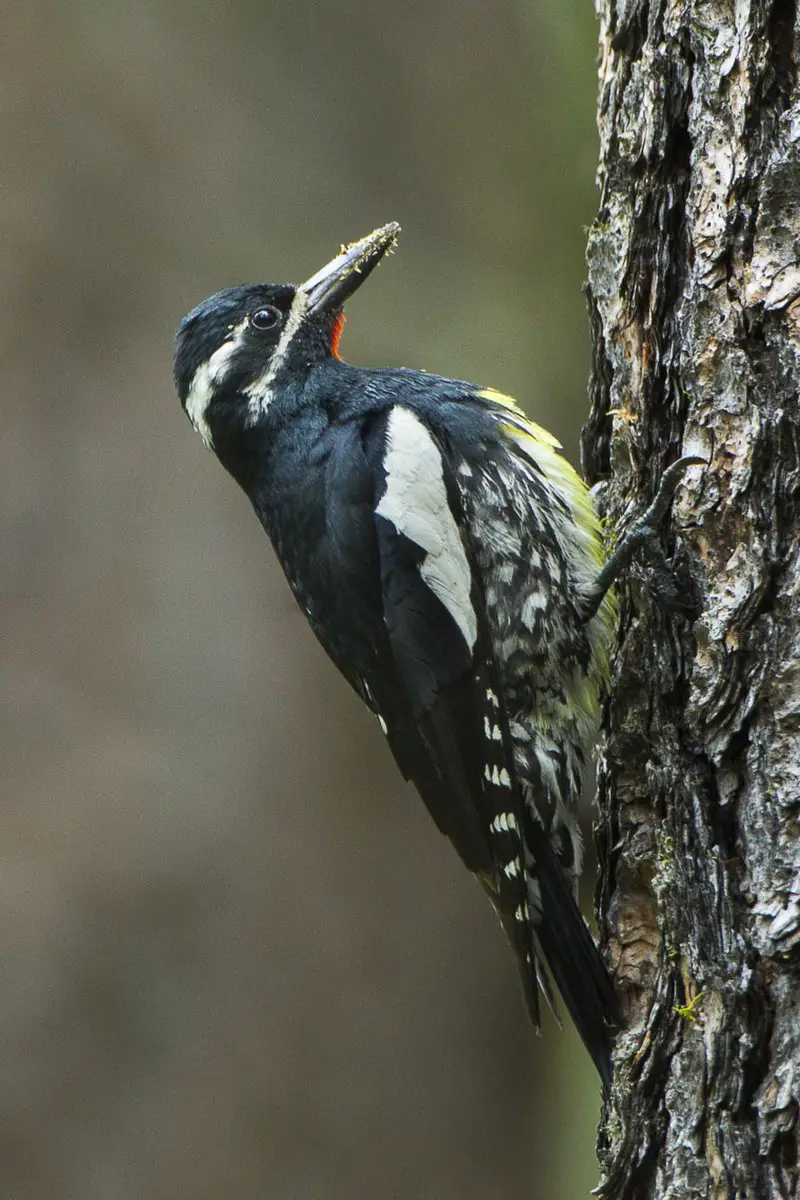
Williamson’s sapsucker is a medium-sized woodpecker belonging to the Sphyrapicus genus.
It inhabits open coniferous forests, particularly those of ponderosa pine, douglas-fir and grand fir in western North America from northern British Columbia through California and as far east as Idaho.
During winter months it can also be found further south into Mexico. Williamson’s sapsuckers feed on arthropods that they drill out from tree bark or sap oozing from their feeding holes—hence its name.
They are an elegant species with glossy black wings patterned by white crescent shaped marks; the back being barred yellowish grey while underparts have fine barring too with chestnut tones around neck area.
In addition, red crowns make males easily distinguishable amongst females who sport dark brown heads instead.Scientific classification:
| Kingdom | Animalia |
| Phylum | Chordata |
| Class | Aves |
| Order | Piciformes |
| Family | Picidae |
| Genus | Sphyrapicus |
| Species | S. thyroideus |
Also Featured In: Yellow Birds that Live in Colorado,
20. White Woodpecker
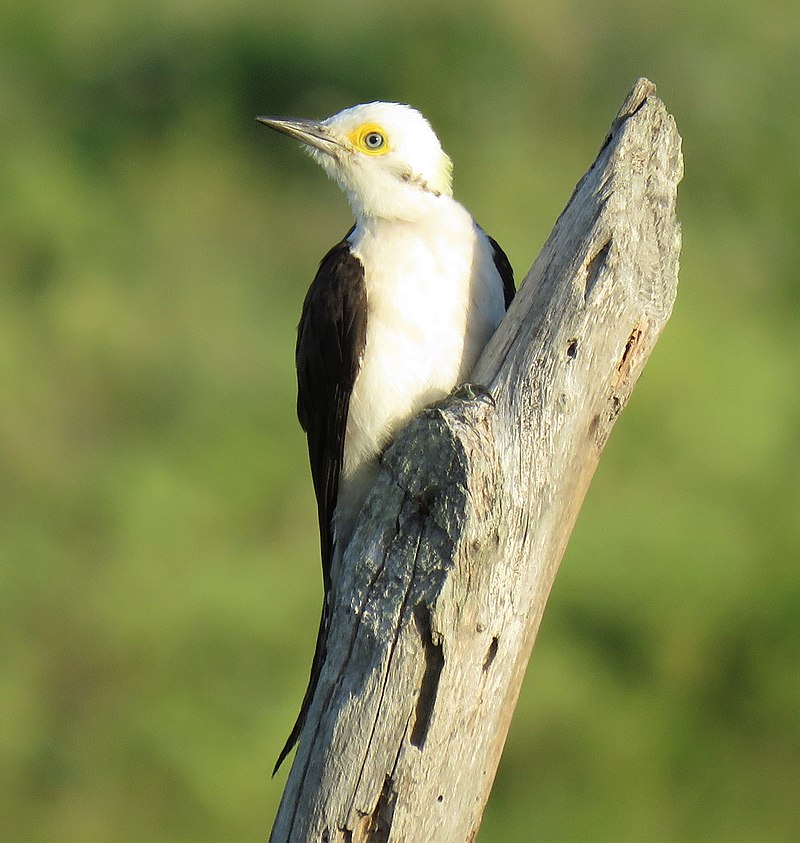
The White woodpecker is a beautiful bird native to South America. It has bright white feathers, black wings and an eye-catching yellow patch on its face.
This species was first discovered in Suriname, French Guiana and other parts of the continent such as Brazil, Bolivia, Paraguay Uruguay and Argentina.
They are quite common across these regions but their population is declining due to habitat destruction caused by deforestation.
In spite of this they have been classified as least concern by the IUCN Red List which means that they won’t be facing immediate extinction concerns anytime soon.
The White woodpecker feeds mainly on insects found in dead trees or areas disturbed by humans like farms or parks making them important members of many ecosystems across South America.Scientific classification:
| Kingdom | Animalia |
| Phylum | Chordata |
| Class | Aves |
| Order | Piciformes |
| Family | Picidae |
| Genus | Melanerpes |
| Species | M. candidus |
21. Red-Breasted Sapsucker
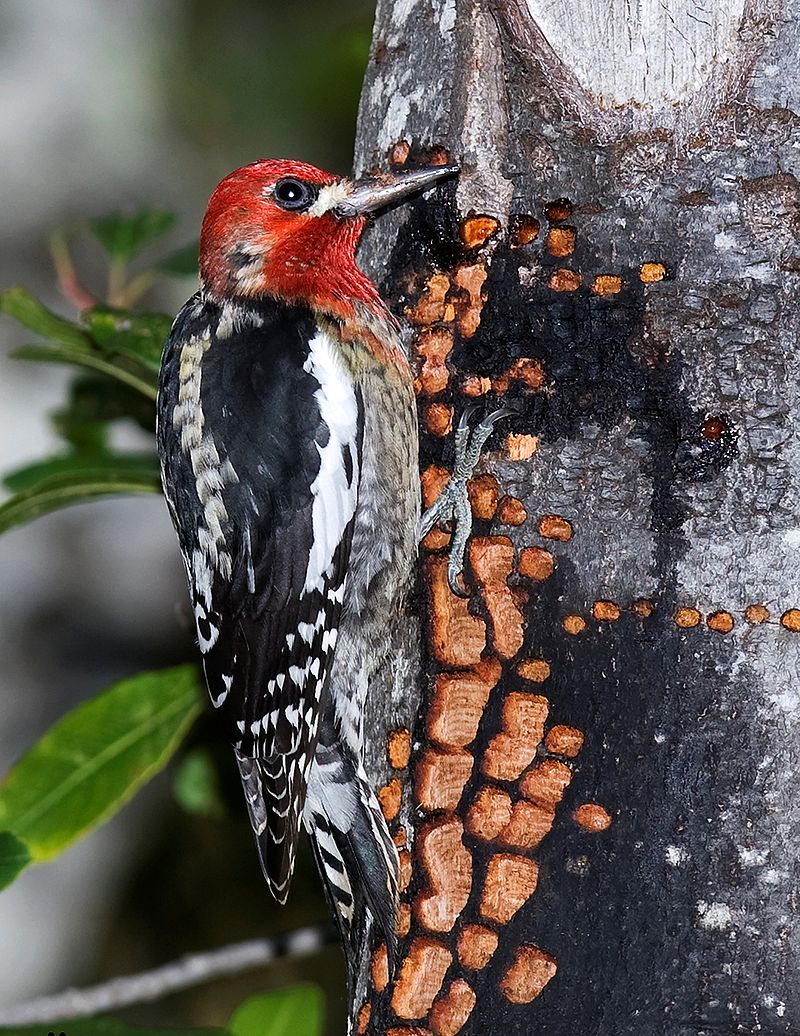
The red-breasted sapsucker is a medium-sized woodpecker native to the forests of the west coast of North America.
It has a striking appearance with its bright red head and upper chest, white lower belly, black back and wings with bars and large white wing patch.
These birds nest in tree cavities during mating season while northern specimens migrate south for winter months.
They are often seen tapping on trees to drill holes into them in order to feed on sap or bark insects that live beneath it.
Additionally, they have been observed feeding from birdfeeders which makes them great additions to backyard bird watching activities.
Overall, the red-breasted sapsucker is an interesting species worth discovering.Scientific classification:
| Kingdom | Animalia |
| Phylum | Chordata |
| Class | Aves |
| Order | Piciformes |
| Family | Picidae |
| Genus | Sphyrapicus |
| Species | S. ruber |
Also Featured In: British Columbian Birds, Birds in Pacific Northwest
22. Black Woodpecker
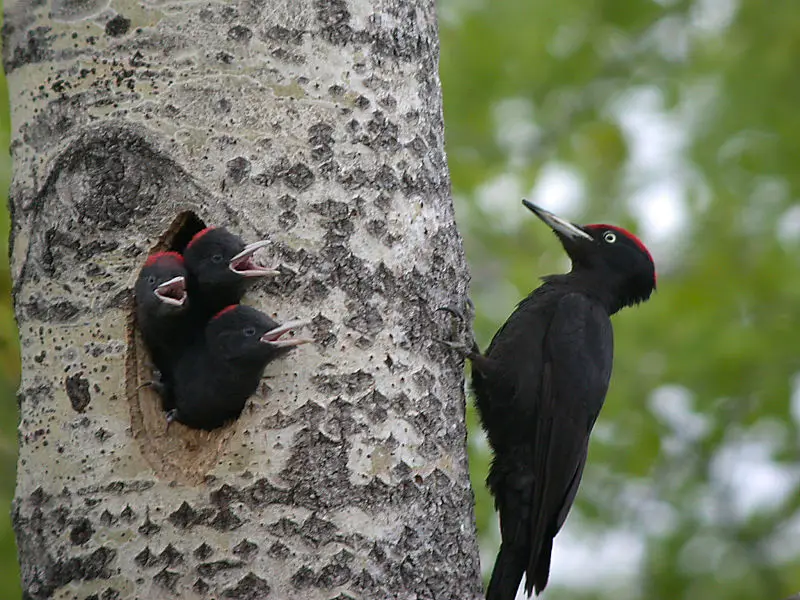
The black woodpecker is an impressive bird found in mature forests across the northern Palearctic region.
It stands out from other species due to its large size and striking black feathers with white spotting on their wings and tail.
Not only is it one of the largest woodpecker species worldwide but also, interestingly, appears to be expanding its range in Europe and Asia as well.
This non-migratory bird loves spending time amongst trees where they can feed off insects which live within tree trunks or branches; tapping away at them with their strong bills until they get a meal.Scientific classification:
| Kingdom | Animalia |
| Phylum | Chordata |
| Class | Aves |
| Order | Piciformes |
| Family | Picidae |
| Genus | Dryocopus |
| Species | D. martius |
23. Arizona Woodpecker
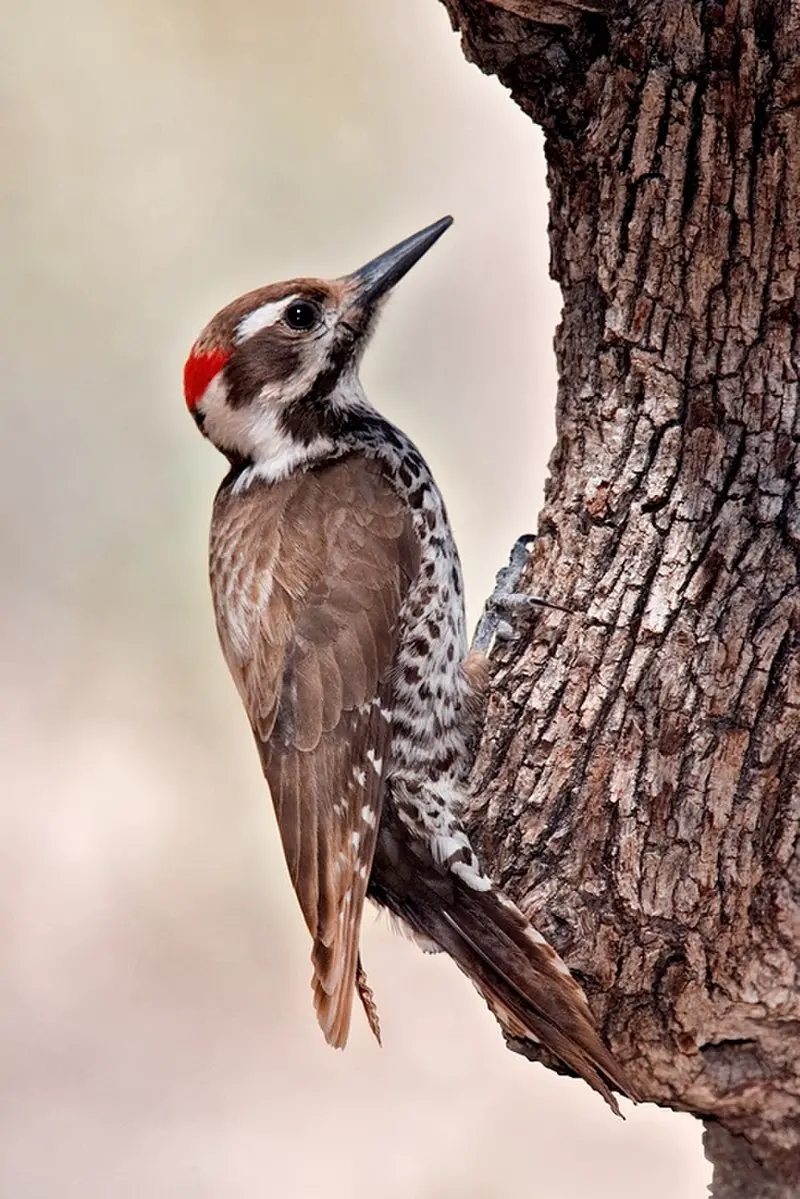
The Arizona Woodpecker is a small, colorful bird native to the Southwest United States and northern Mexico.
With its striking black and white stripes on its back, red crown and nape patch, it stands out in the desert landscape.
It inhabits mostly pine-oak woodlands at higher elevations of 4500 feet or more. This species feeds mainly on insects found beneath tree bark but will also eat fruit when available.
Their drumming can be heard up to 1/2 mile away.
These birds are vulnerable due to their limited range and habitat loss from logging activities in these areas.
Conservation efforts must remain focused where they live if we want future generations of this amazing bird alive for us all to enjoy.Scientific classification:
| Kingdom | Animalia |
| Phylum | Chordata |
| Class | Aves |
| Order | Piciformes |
| Family | Picidae |
| Genus | Leuconotopicus |
| Species | L. arizonae |
Also Featured In: Most Common Birds Found in Nayarit,
24. Gilded Flicker
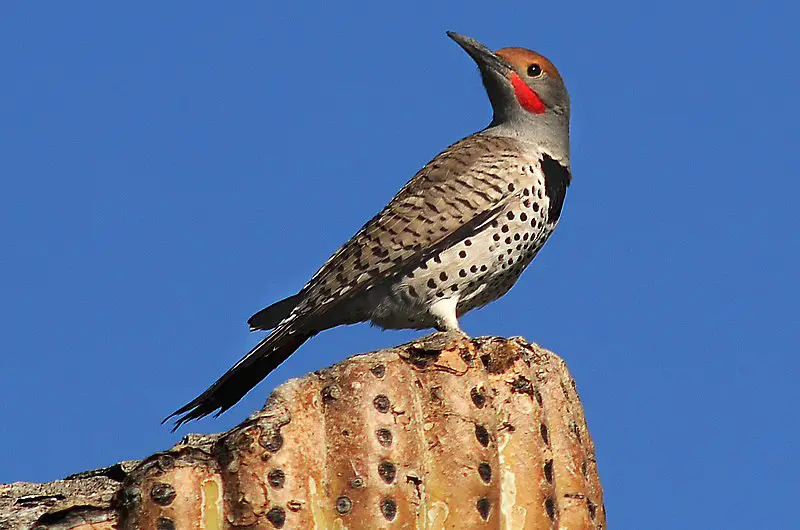
The Gilded Flicker is an impressive and striking bird that can be found in the desert regions of Southwestern United States and Northwestern Mexico.
It has a mean length of 29 cm (11 inches) which makes it one of the largest woodpeckers.
Its distinguishing feature is its golden-yellow underwings, making it stand out from other species such as the northern flicker in these areas.
This majestic bird mainly consumes insects but may also feed on fruits or berries when available, helping to spread seeds throughout their habitats.
As they are not migratory birds, they remain all year round; hence providing some stability to their local ecosystems.Scientific classification:
| Kingdom | Animalia |
| Phylum | Chordata |
| Class | Aves |
| Order | Piciformes |
| Family | Picidae |
| Genus | Colaptes |
| Species | C. chrysoides |
Also Featured In: Birds that Live in Arizona Desert, Birds You’ll Find in Sonoran
25. Lesser Spotted Woodpecker
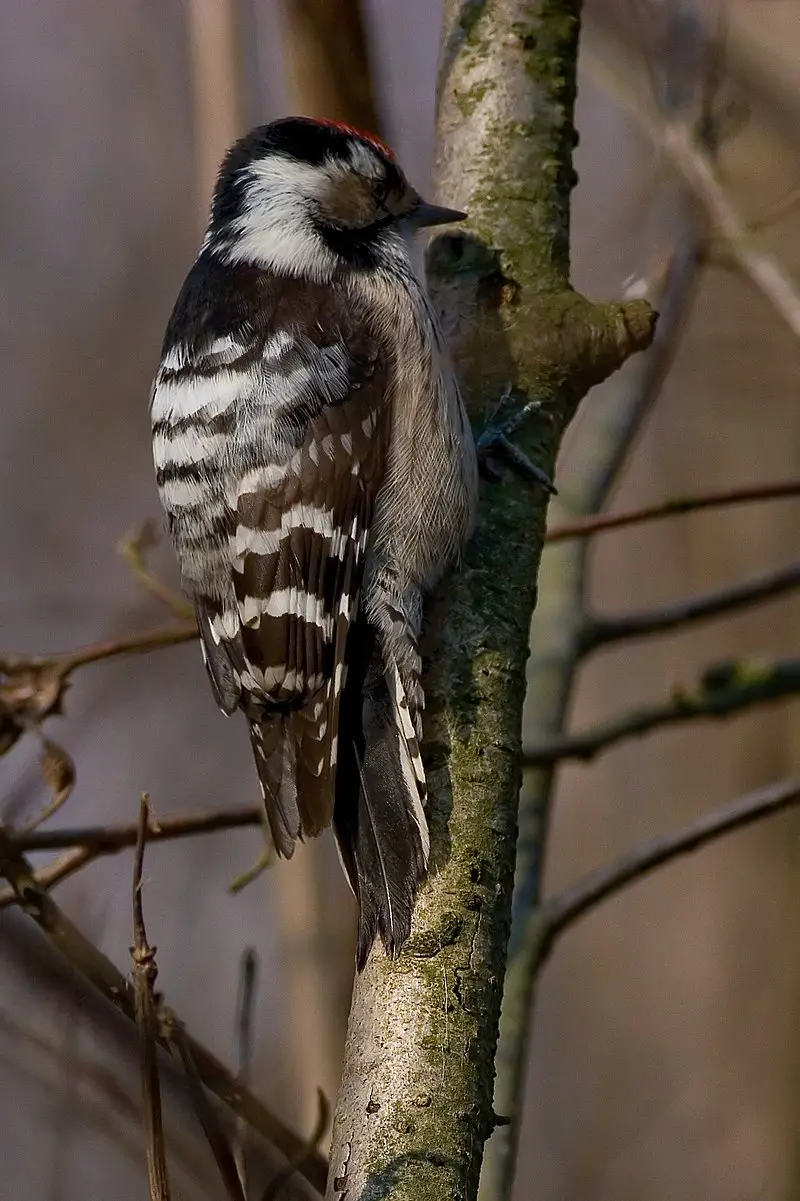
The Lesser Spotted Woodpecker (Dryobates minor) is a small, attractive bird belonging to the woodpecker family Picidae.
It is found in much of Europe and parts of Asia.
The species was previously classified under the genus Dendrocopos but has now been reassigned to Dryobates.
This beautiful little bird is characterized by its brown body with black wings, tail and head.
Its belly and throat are white while there are red patches on both sides of its neck-collar region. In addition, it also possesses yellowish stripes near its eyes that make it look quite smart.
The lesser spotted woodpeckers feed mainly on insects such as ants and beetles which they find beneath tree bark or among dead leaves.
They can be seen foraging alone or in pairs since they prefer living an isolated life away from human settlements.
Thus if you ever wish to spot one remember not to disturb them during their search for food else you might miss out this amazing opportunity.Scientific classification:
| Kingdom | Animalia |
| Phylum | Chordata |
| Class | Aves |
| Order | Piciformes |
| Family | Picidae |
| Genus | Dryobates |
| Species | D. minor |
26. European Green Woodpecker
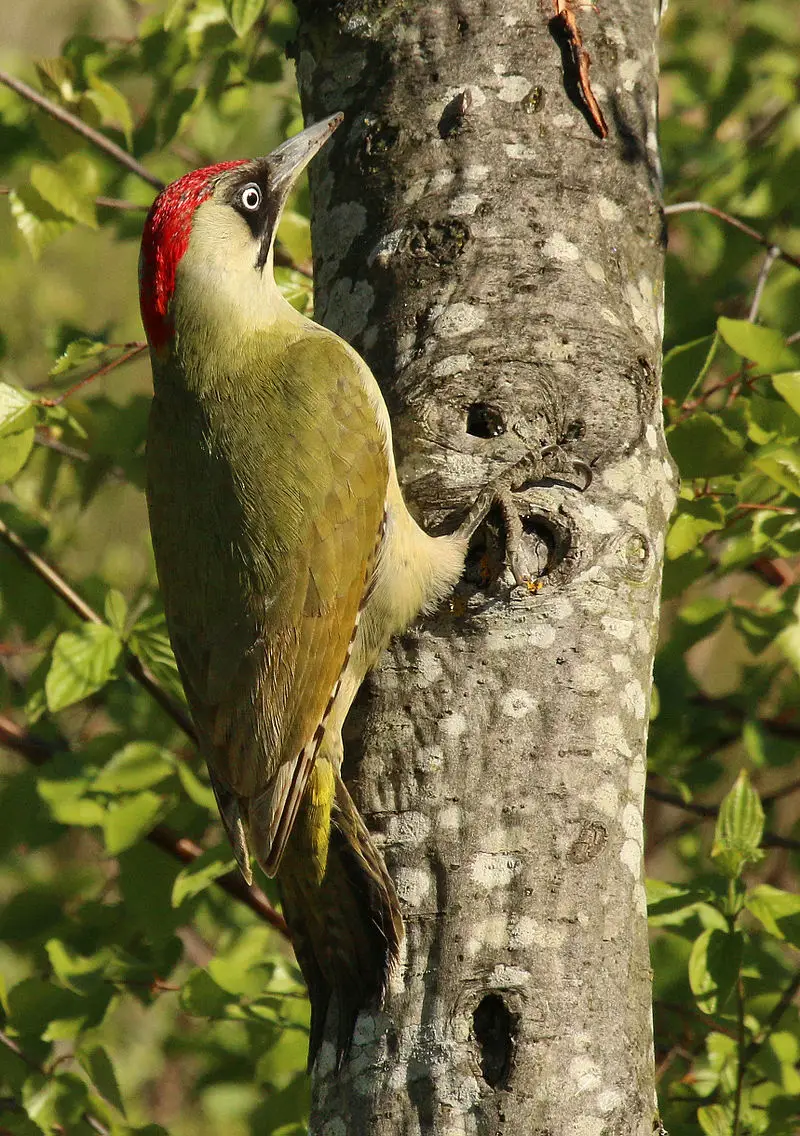
The European green woodpecker is a vibrant species with striking features. The body has an emerald hue, while males have a red crown and black moustache that extends to the middle of their forehead.
Females lack this characteristic feature but instead possess barred markings beneath the wings as well as yellow throats and cheeks.
It can be found in many parts of Europe and western Palearctic regions such as Spain and Portugal where it is replaced by its similar cousin; Iberian green woodpecker (Picus sharpei).
This bird loves inhabiting open forests or grasslands for its food source which typically consists on insects like ants, beetles, spiders among others.
Its powerful bill allows it to dig into tree bark searching for larvae underneath making it an efficient predator in these environments.Scientific classification:
| Kingdom | Animalia |
| Phylum | Chordata |
| Class | Aves |
| Order | Piciformes |
| Family | Picidae |
| Genus | Picus |
| Species | P. viridis |
27. Eurasian Three-Toed Woodpecker
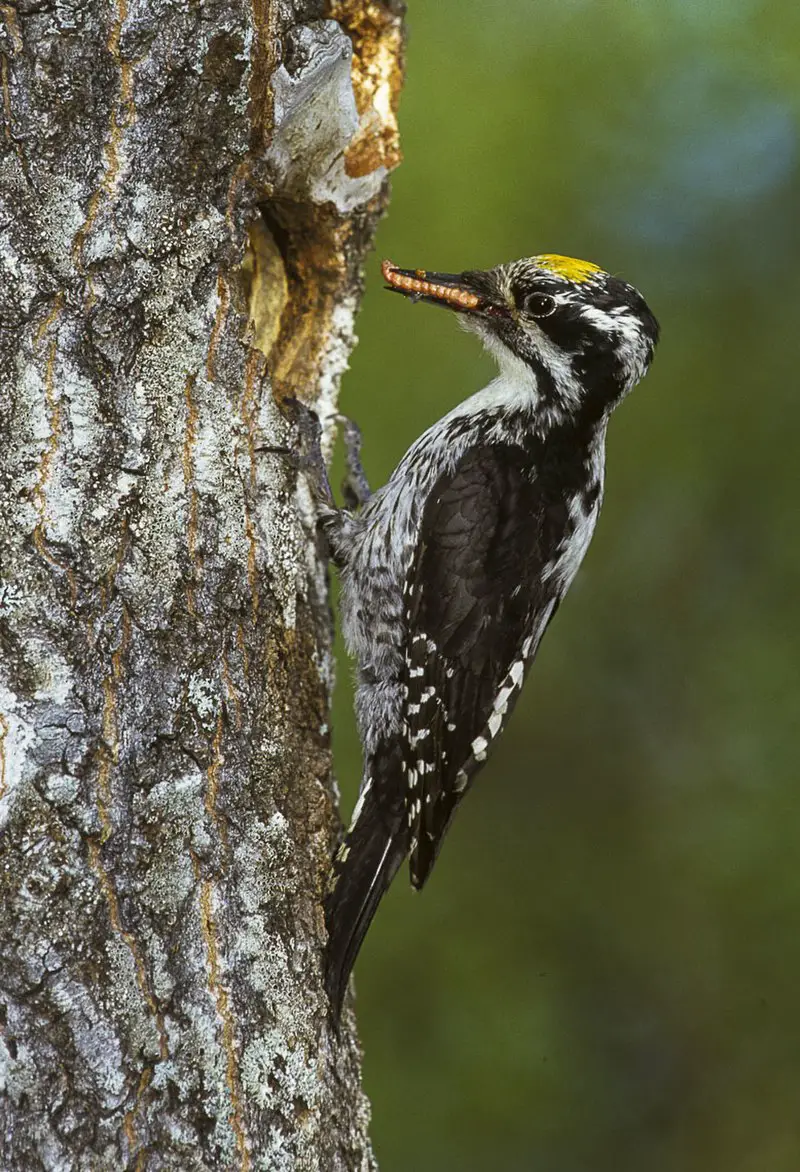
The Eurasian three-toed woodpecker is a beautiful medium sized bird found from northern Europe to Japan.
It was first formally described by Swedish naturalist Carl Linnaeus in 1758 and has since become an iconic species due to its distinctive black, white and red plumage as well as its adaptations for living in cold climates.
The Eurasian three-toed woodpecker lives mainly on coniferous trees such as spruce or fir, where it finds insect larvae under the bark of deadwood which forms part of its diet.
Its most recognizable feature is the bright yellow stripe running down each side of its head, making it easy to identify even at great distances.
This shy but tough creature can survive subzero temperatures with ease thanks to their thick feathers and specialised feet that allow them to cling onto icy branches.Scientific classification:
| Kingdom | Animalia |
| Phylum | Chordata |
| Class | Aves |
| Order | Piciformes |
| Family | Picidae |
| Genus | Picoides |
| Species | P. tridactylus |
28. Eurasian Wryneck
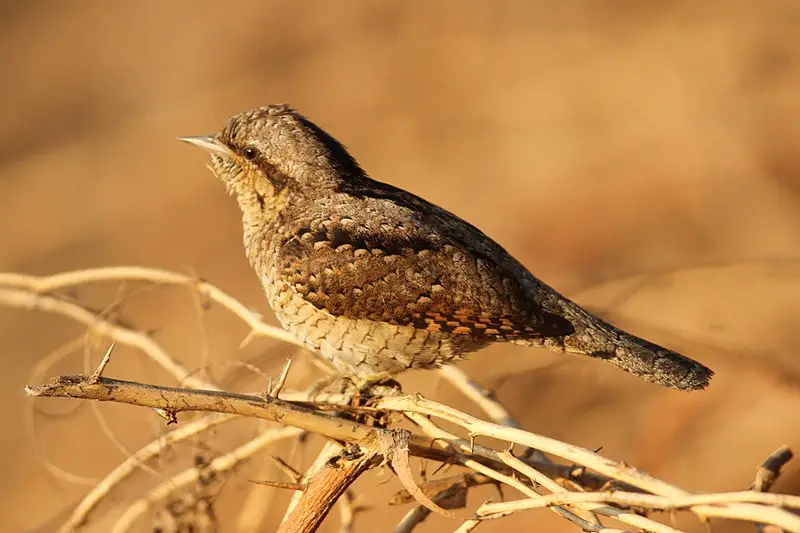
The Eurasian Wryneck is a species of woodpecker found in temperate regions of Europe and Asia. They breed during the summer months, but migrate south to tropical Africa or southern Asia for winter.
These birds are quite adaptable when it comes to their habitat, as they can be seen in open countryside, woodland, orchards and gardens alike.
To identify them you should look out for their distinctive brownish-grey feathers with black bars on the wings and tail; males also have red markings around their neck too.
Their diet consists mainly of insects which they find by probing into loose bark on trees or digging through soil with its sharp bill.
All in all an amazing bird that deserves more attention.Scientific classification:
| Kingdom | Animalia |
| Phylum | Chordata |
| Class | Aves |
| Order | Piciformes |
| Family | Picidae |
| Genus | Jynx |
| Species | J. torquilla |
29. Red-Crowned Woodpecker
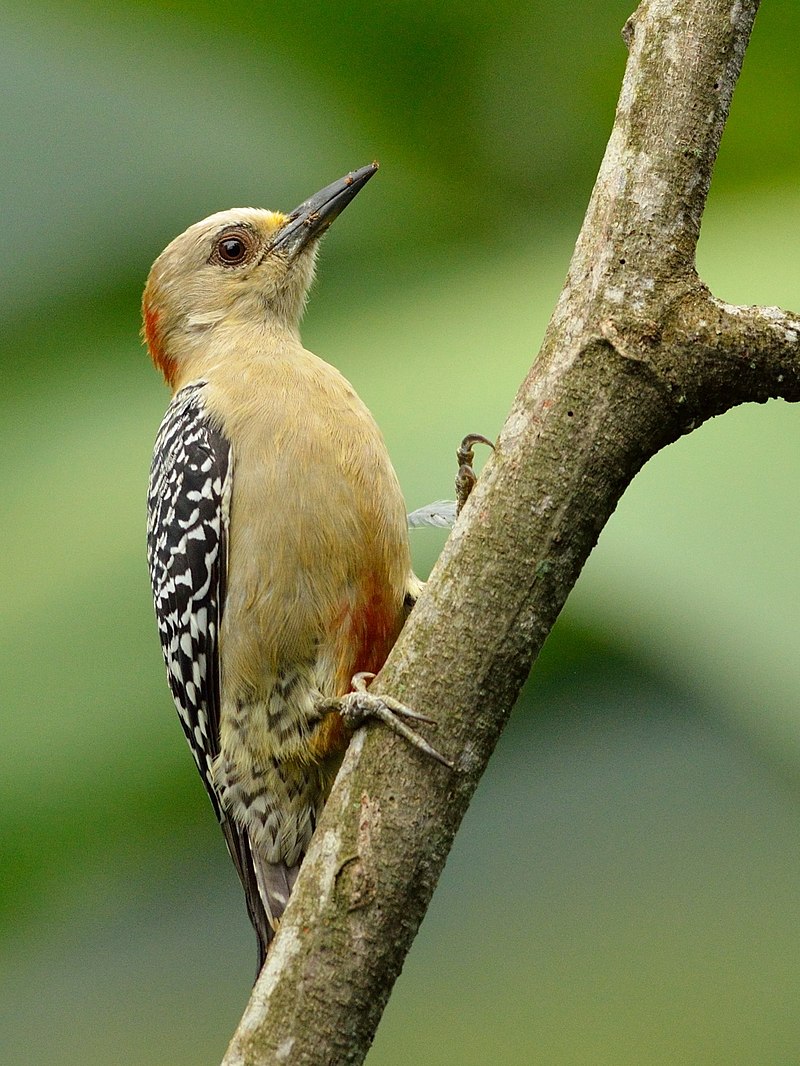
The red-crowned woodpecker is a striking bird, native to areas of Central and South America.
It measures 17 cm in length and weighs 55 g, with black and white zebra-barred wings and back contrasting against its pale buff brown underparts.
The most eye catching feature though is the male’s bright red crown, which has earned it its name.
This species prefers open forests or woodland edges where they can find their favourite food – insects hidden in dead tree trunks.
When not hunting for food these birds will often be seen drumming on trees as part of courtship rituals between males or as territorial displays towards other animals invading their territory.Scientific classification:
| Kingdom | Animalia |
| Phylum | Chordata |
| Class | Aves |
| Order | Piciformes |
| Family | Picidae |
| Genus | Melanerpes |
| Species | M. rubricapillus |
30. Grey-Headed Woodpecker
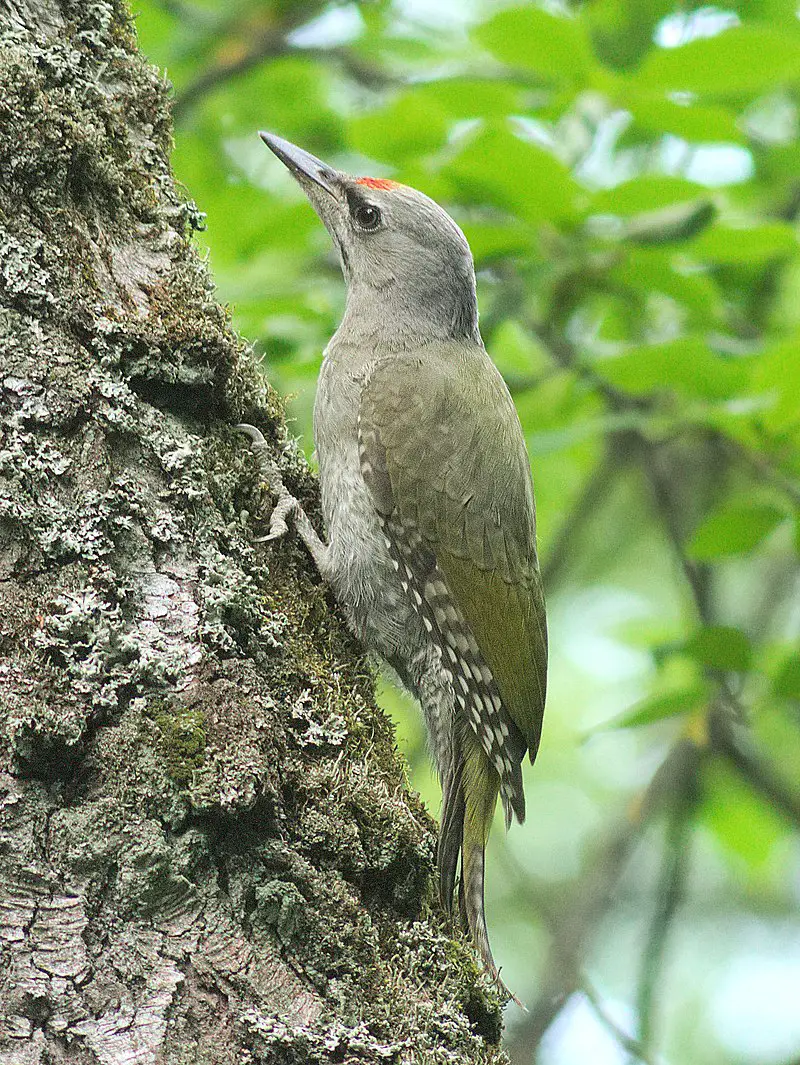
The Grey-headed Woodpecker is a species of bird found in the Eurasian region, belonging to the family Picidae.
It has distinctive grey feathers on its head and back, making it easily identifiable compared to other woodpeckers.
This species can be seen across large parts of Europe and Central Asia, all the way up into Northern Siberia.
The diet consists mainly of small insects such as ants and beetles which they locate by tapping or drilling holes into tree bark looking for larvae underneath; this behaviour also helps them find nesting cavities within trees for their homes.
They are very social creatures that like to live in groups with many birds from different generations living together at once.Scientific classification:
| Kingdom | Animalia |
| Phylum | Chordata |
| Class | Aves |
| Order | Piciformes |
| Family | Picidae |
| Genus | Picus |
| Species | P. canus |
31. Hispaniolan Woodpecker
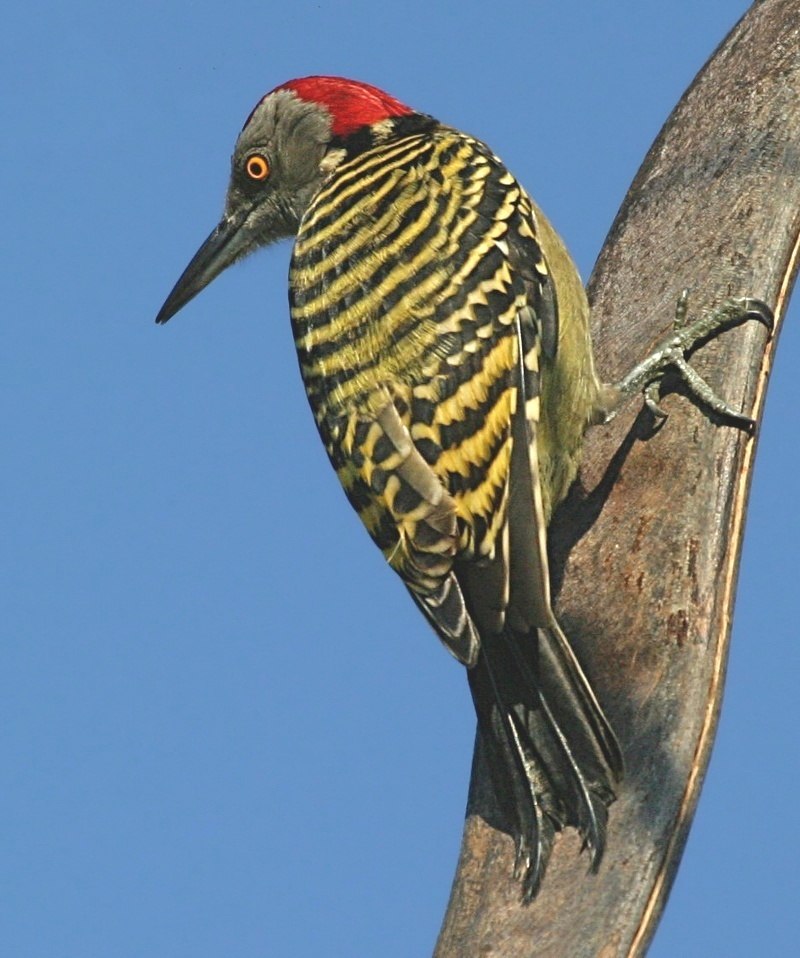
The Hispaniolan woodpecker is a beautiful bird endemic to the Caribbean island of Hispaniola. It has gold and black barred feathers, with males having an added red crown and nape.
The male also has a longer beak than the female, with its upper neck being white in coloration.
This medium-sized woodpecker grows up to 22 – 28 cm long and can often be seen pecking away at tree bark or logs while looking for food such as insects larvae, spiders, lizards and other small animals.
They mainly inhabit broadleaf forests but can also sometimes be found near plantations or secondary growth areas too.
With their distinctive calls heard throughout these habitats during mating season it’s easy to spot them amongst any greenery that you may come across on this lovely island.Scientific classification:
| Kingdom | Animalia |
| Phylum | Chordata |
| Class | Aves |
| Order | Piciformes |
| Family | Picidae |
| Genus | Melanerpes |
| Species | M. striatus |
32. Campo Flicker
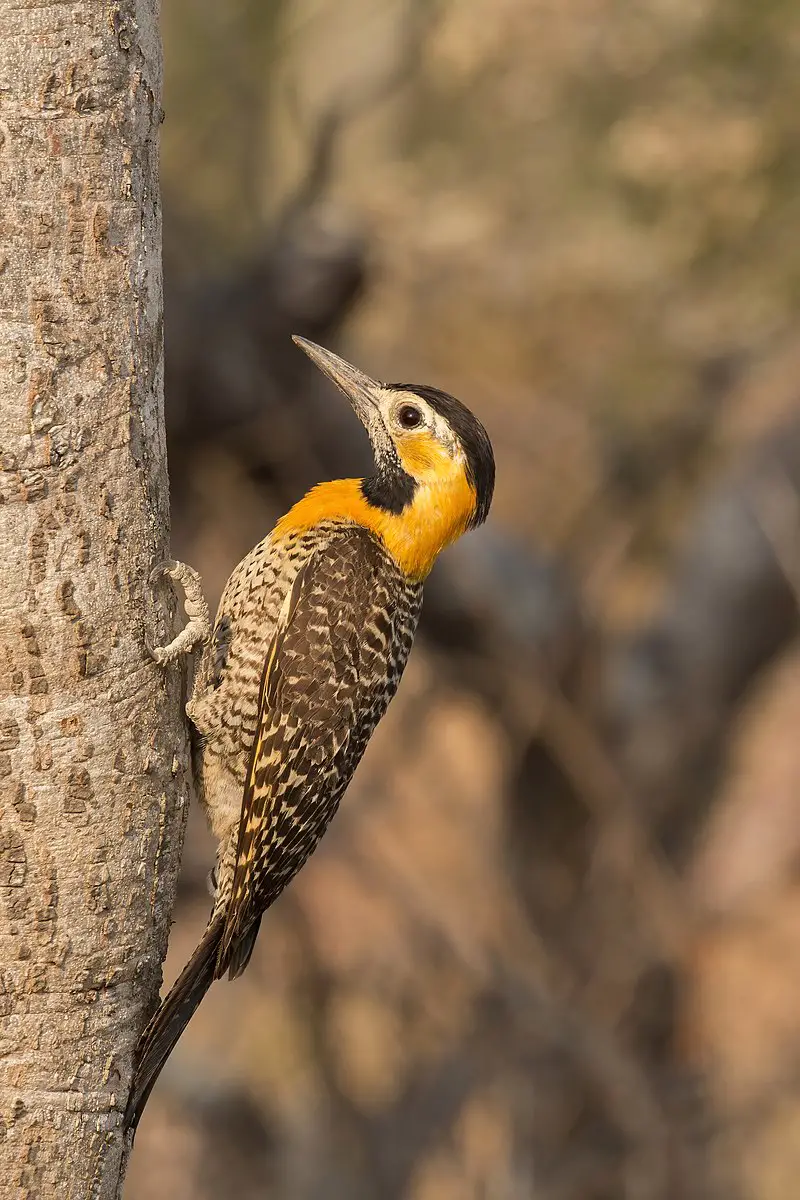
The Campo Flicker is a species of bird from the woodpecker family, found in eastern Brazil and parts of Argentina, Bolivia, Paraguay and Uruguay. It also has isolated populations located in Amapa and southern Suriname.
This cute little creature’s body length ranges between 28 to 31 cm (11-12 inches) with an estimated weight of 145 to 192 gm (0.31- 0.42 lb).
Its feathers are predominantly brownish yellow on its back while its chest area is white with black spots all over it making it look attractive yet unique.
Their diet mostly consists of ants which they dig up using their beaks but they can also feed upon fruits or some other small insects as well if need arises.Scientific classification:
| Kingdom | Animalia |
| Phylum | Chordata |
| Class | Aves |
| Order | Piciformes |
| Family | Picidae |
| Genus | Colaptes |
| Species | C. campestris |
33. Andean Flicker
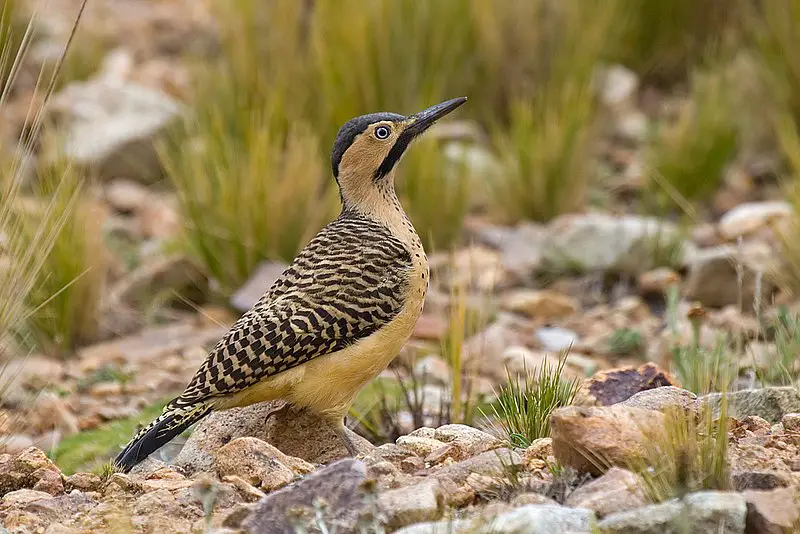
The Andean Flicker is a South American species of woodpecker, found in grasslands and shrublands at altitudes between 2,000-5,000 metres.
It stands out amongst other woodpeckers due to its largely terrestrial lifestyle.
This large bird has an impressive length of 32 cm and features reddish brown upperparts with white underparts.
Its face bears a distinctive black moustache mark on each side which gives it an iconic look.
The inner wings are yellow or orangey red whereas the outer ones are barred greyish white and chestnut colouring can be seen around the neck region.
They have long bills for probing into deep crevices when searching for food such as insects, grubs and small reptiles or amphibians that live beneath tree bark or soil surfaces near streams or rivers etcetera.
Their loud calls are often heard throughout their natural range during breeding season from September – November .Scientific classification:
| Kingdom | Animalia |
| Phylum | Chordata |
| Class | Aves |
| Order | Piciformes |
| Family | Picidae |
| Genus | Colaptes |
| Species | C. rupicola |
34. Grey-Capped Pygmy Woodpecker
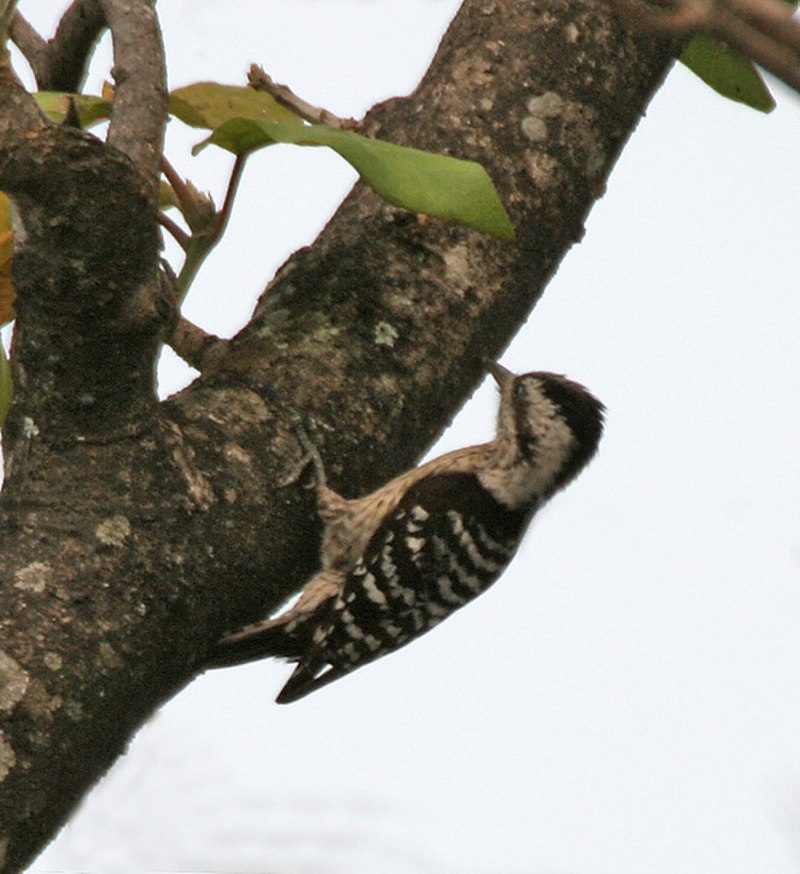
The Grey-capped Pygmy Woodpecker is a small, dark bird of the Picidae family. Found in Asia, it has a subspecies located mainly in Manchuria and Korea.
It has an iridescent black head with grey cap feathers which contrast against its pale yellowish-brown body plumage.
Its wings are barred white on their outer edges while its tail is marked by round spots that alternate between buff and grey colours as they move from base to tip.
This species can be found foraging among tree branches or tapping away at trees looking for food such as insects larvae and fruits which make up most of their diet supplemented occasionally with seeds and nectar from flowers.
They usually nest in cavities excavated into dead wood where both parents take turns incubating eggs until hatching occurs after about 17 – 19 days.Scientific classification:
| Kingdom | Animalia |
| Phylum | Chordata |
| Class | Aves |
| Order | Piciformes |
| Family | Picidae |
| Genus | Yungipicus |
| Species | Y. canicapillus |
Also Featured In: Most Common Taiwan Birds,
35. Rufous-Bellied Woodpecker
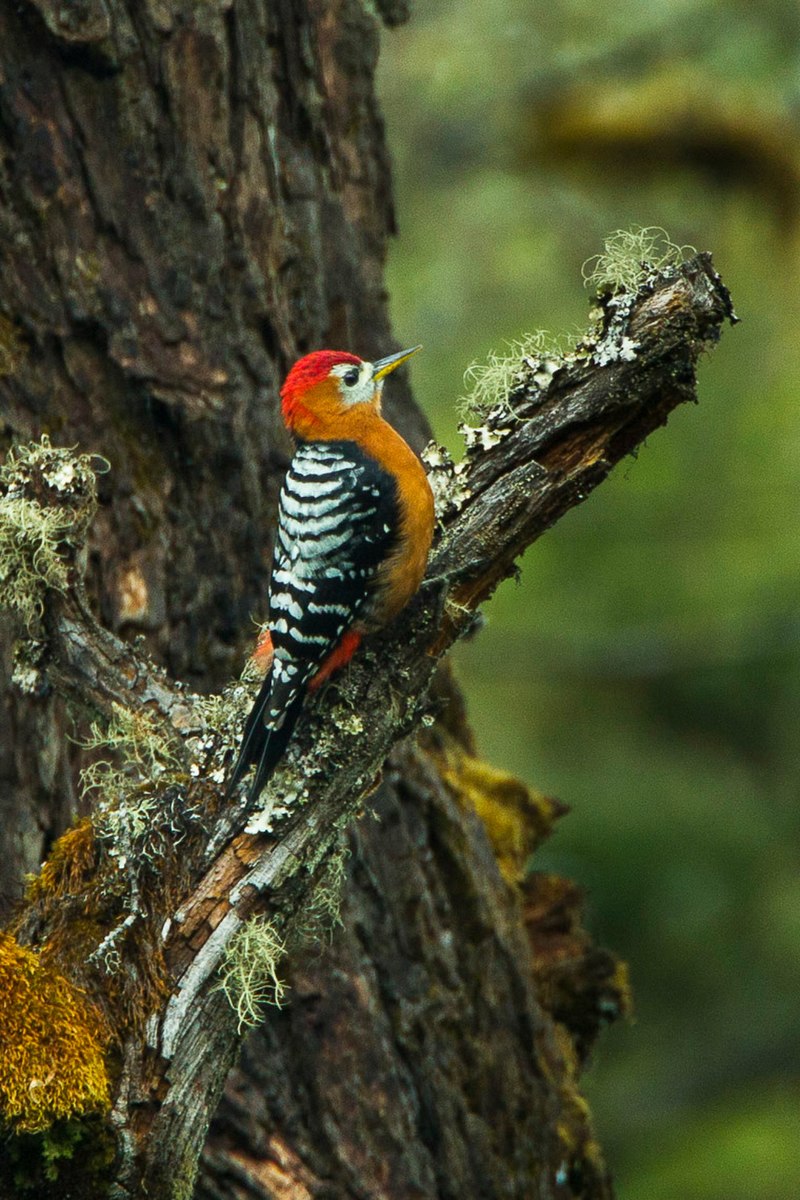
The Rufous-bellied woodpecker is a species of bird that belongs to the Picidae family. It can be found in Bangladesh, Bhutan and India throughout Southeast Asia along the Himalayas.
Its unique behavior often leads it to being confused with an Asiatic sapsucker as they frequently make small pits on trees’ bark which give them their name.
This species has a brownish backside contrasted with its rufous colored belly, wings and tail feathers as well as white markings across its face giving it unmistakable features amongst other birds in this region.
With large eyes located at the sides of its head, these woodpeckers have excellent vision allowing them to find insects hidden beneath tree bark while they search for food or build nests during mating season.Scientific classification:
| Kingdom | Animalia |
| Phylum | Chordata |
| Class | Aves |
| Order | Piciformes |
| Family | Picidae |
| Genus | Dendrocopos |
| Species | D. hyperythrus |
36. Bamboo Woodpecker
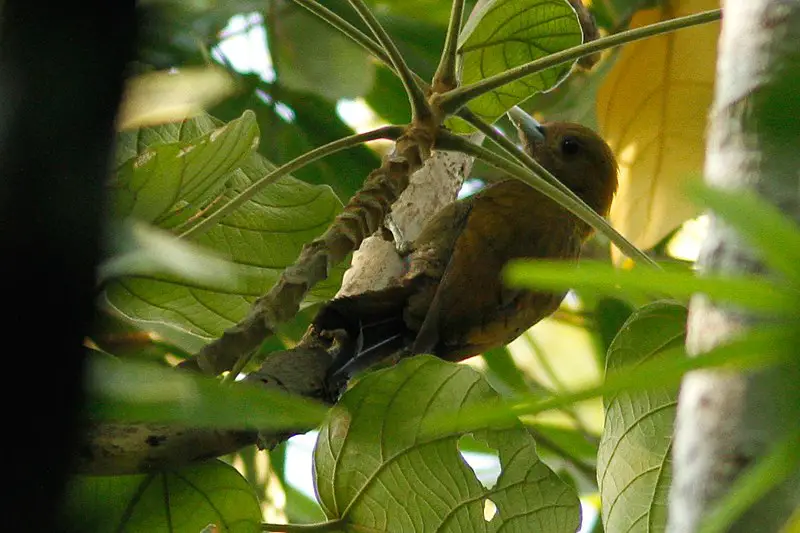
The Bamboo Woodpecker is a species of bird found in Myanmar, Laos, Thailand and Malaysia. It has distinctive green plumage with black markings on its wings and tail feathers.
Its bill is yellowish-orange at the base, becoming white towards the tip.
The woodpecker lives mainly in subtropical or tropical dry forests as well as moist lowland forests where it feeds mostly on insects hidden inside bamboo shoots or trees such as palm oil and rubber trees.
This species plays an important role in maintaining healthy forest ecosystems by helping to disperse seeds from various plant types while foraging for food among deadwood branches.
These birds are also known to drum loudly against tree trunks when communicating with other members of their flock which can be heard up to 1 km away.Scientific classification:
| Kingdom | Animalia |
| Phylum | Chordata |
| Class | Aves |
| Order | Piciformes |
| Family | Picidae |
| Genus | Gecinulus |
| Species | G. viridis |
37. Hemicircus Sordidus
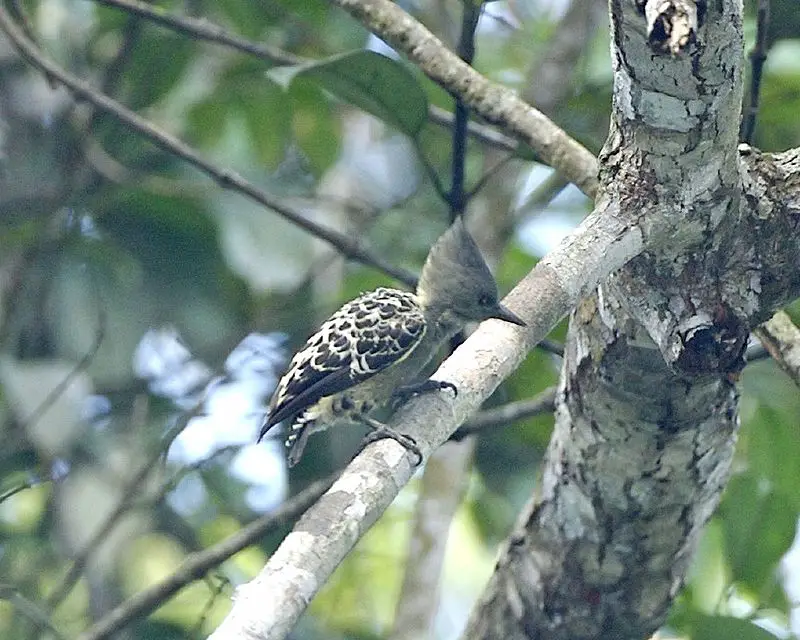
The grey-and-buff woodpecker, scientifically known as Hemicircus concretus, is a species of bird belonging to the family Picidae.
It inhabits areas in Brunei, Indonesia (Sumatra and Borneo), Malaysia, southern Myanmar and Southern Thailand.
Unfortunately this beautiful bird has become regionally extinct in Singapore due to habitat loss and degradation.
This species prefers living in lowland or montane tropical or subtropical moist broadleaf forests for its natural habitats.
The formal description of the grey-and-buff woodpecker was made by German ornithologist Jean Cabanis who named it after its distinctive colors – grey body with buff wings & tail feathers which make it look distinct from other birds in its range.
Conservation efforts are being carried out to protect this endangered species so that they can continue thriving across their native ranges without facing extinction like many others did before them.Scientific classification:
| Kingdom | Animalia |
| Phylum | Chordata |
| Class | Aves |
| Order | Piciformes |
| Family | Picidae |
| Genus | Hemicircus |
| Species | H. concretus |
Also Featured In: Birds that Live in Kuala Lumpur,
38. West Indian Woodpecker
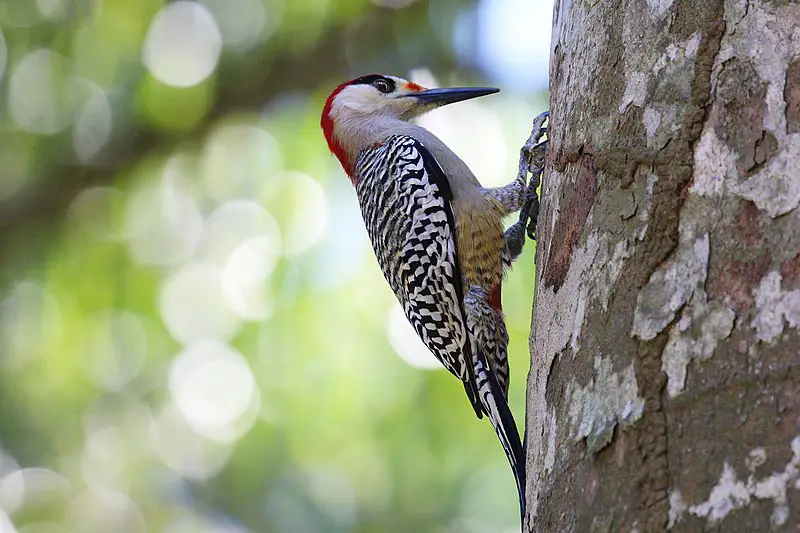
The West Indian woodpecker is a species of bird belonging to the family Picidae. It can be found in Cuba, the Bahamas and the Cayman Islands, living mainly in subtropical or tropical dry forest, lowland moist forests and mangrove habitats.
This species has been observed to exhibit polyandrous breeding behaviour – meaning that one female mates with multiple males at once – making it quite unique among its peers.
The diet of this bird consists mostly of insects which are gleaned from tree trunks by probing or drilling into them using their powerful bills; they will also feed on fruits when available.
Despite being listed as Least Concern by IUCN Red List due to its wide range and stable population, human activities such as deforestation have caused some decline in numbers for this species.Scientific classification:
| Kingdom | Animalia |
| Phylum | Chordata |
| Class | Aves |
| Order | Piciformes |
| Family | Picidae |
| Genus | Melanerpes |
| Species | M. superciliaris |
39. Great Slaty Woodpecker
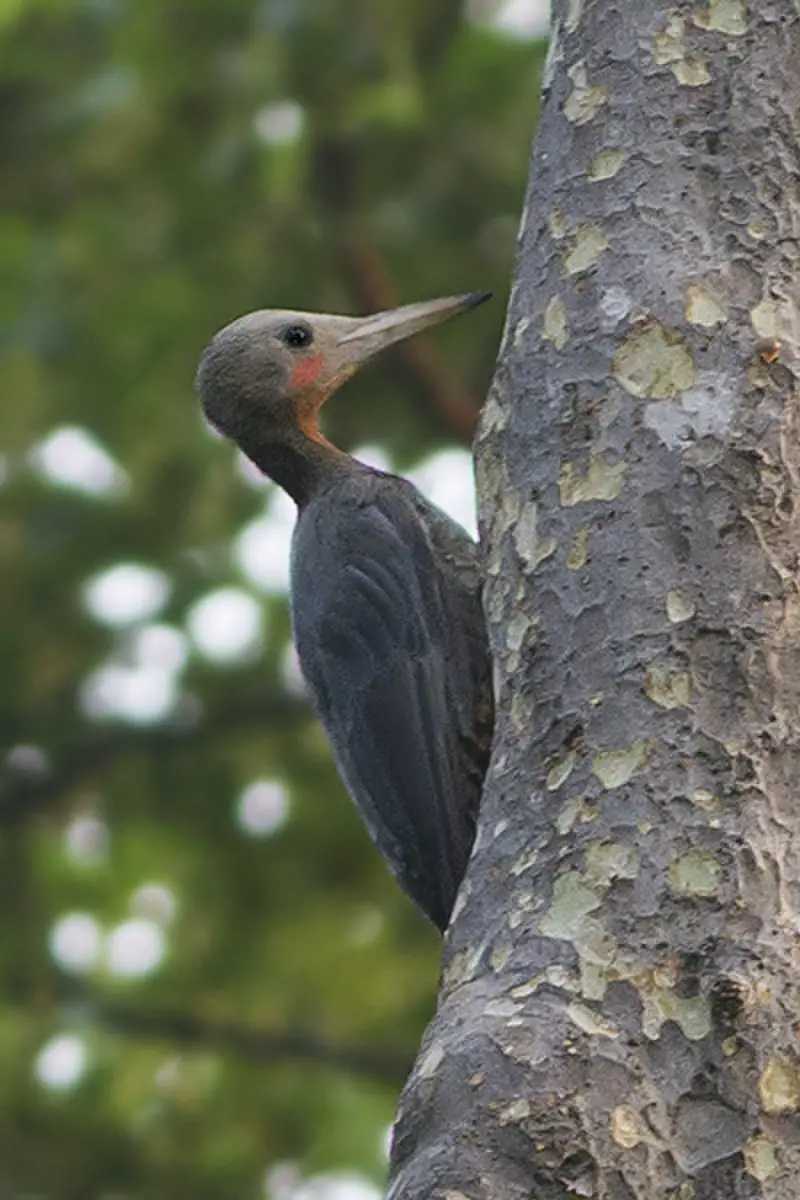
The Great Slaty Woodpecker is a stunning bird, easily recognizable with its unique coloration. It sports greyish-black wings and back, white underparts and an off-white to yellow belly.
These birds range across the Indian subcontinent and Southeast Asia; they can be found in Bangladesh, Bhutan, India (including Andaman Islands), Nepal, Myanmar (formerly Burma) Laos PDR., Thailand Vietnam as well as parts of China including Taiwan.
They are gregarious species that form large flocks when foraging or roosting. This woodpecker feeds mainly on insects such as ants but also consume fruits occasionally during non breeding season months.
The great slaty woodpecker is not only beautiful but also uniquely adapted to life among trees which makes it an interesting subject for observation by naturalists around the world.Scientific classification:
| Kingdom | Animalia |
| Phylum | Chordata |
| Class | Aves |
| Order | Piciformes |
| Family | Picidae |
| Genus | Mulleripicus |
| Species | M. pulverulentus |
Also Featured In: Big Birds that Live in Singapore,
40. Bar-Breasted Piculet
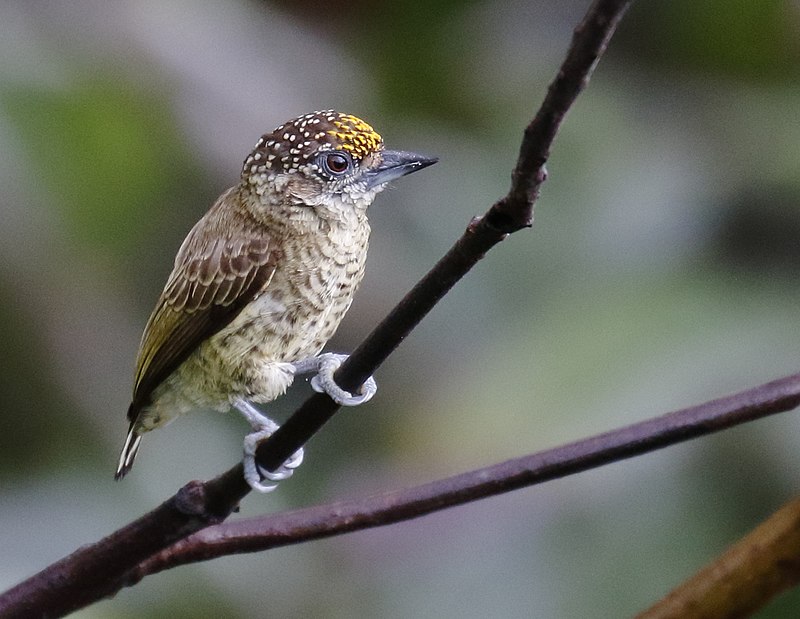
The Bar-breasted piculet is a species of small bird found in Bolivia, Brazil, Colombia and Peru. It has seven subspecies: P.a borbae, P.A wallacii, and P.a juruanus to name a few which have been treated as individual species at times by some researchers.
These birds are usually seen foraging on the ground or perched low down among branches of trees looking out for insects or other prey like spiders and lizards etc..
They possess long pointed bills that help them dig into bark crevices searching for food items such as larvae & pupal cases hidden inside tree trunks.
The bar-breasted piculet generally inhabits dry deciduous forest patches with plenty of available perching sites provided by leafless shrubs & trees making it easier to spot their predators from above.Scientific classification:
| Kingdom | Animalia |
| Phylum | Chordata |
| Class | Aves |
| Order | Piciformes |
| Family | Picidae |
| Genus | Picumnus |
| Species | P. aurifrons |
41. Ochre-Collared Piculet
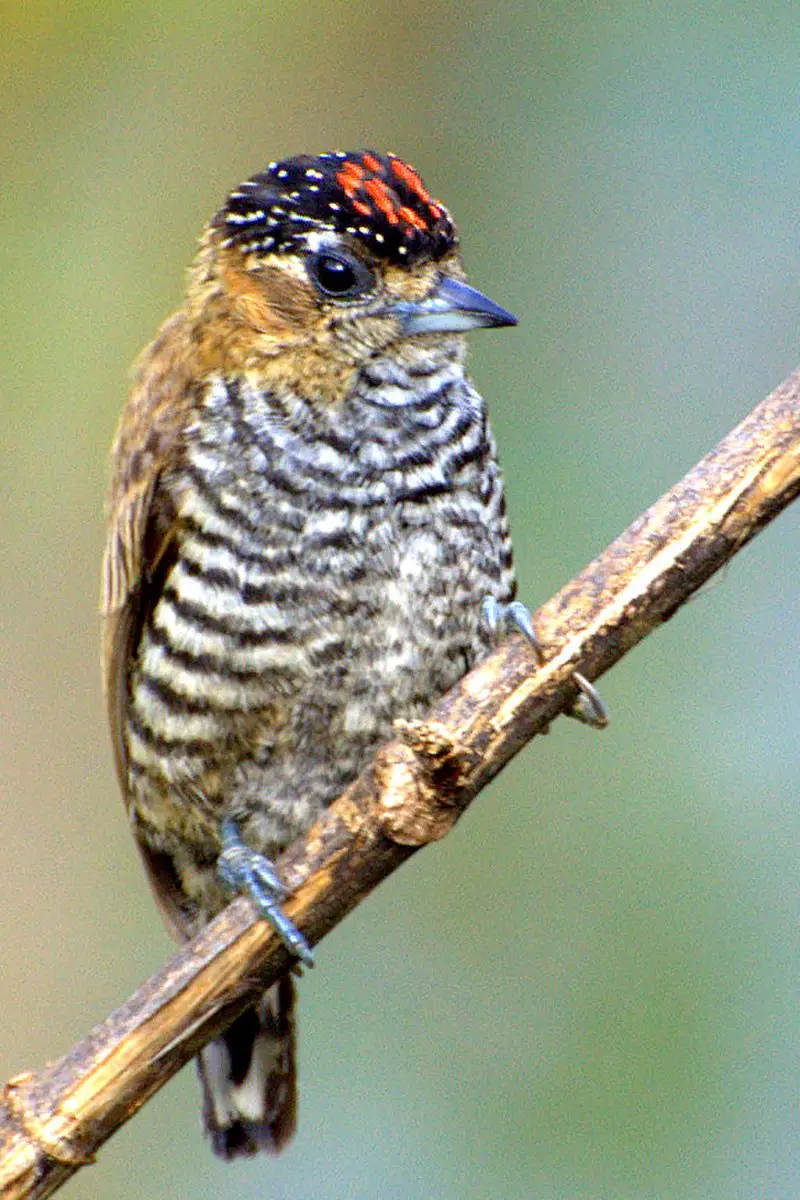
The Ochre-collared piculet is a species of bird found in Argentina, Brazil and Paraguay. It belongs to the Picumninae subfamily of the woodpecker family Picidae.
While it is monotypic, its taxonomy along with that of other members of genus Pucumnus are uncertain due to their close relation with another species -the White-barred piculet (P cirratus).
The ochre-collared piculet has an olive green plumage on most parts while its head shows yellowish tones.
Its undersides are white or light grey and its tail feathers have black tips at each end as well as a red band around them near halfway down from base.
This small bird measures upto 12 cm long and weighs between 8–14 gm making it one among the smallest birds in South America.Scientific classification:
| Kingdom | Animalia |
| Phylum | Chordata |
| Class | Aves |
| Order | Piciformes |
| Family | Picidae |
| Genus | Picumnus |
| Species | P. temminckii |
42. Middle Spotted Woodpecker
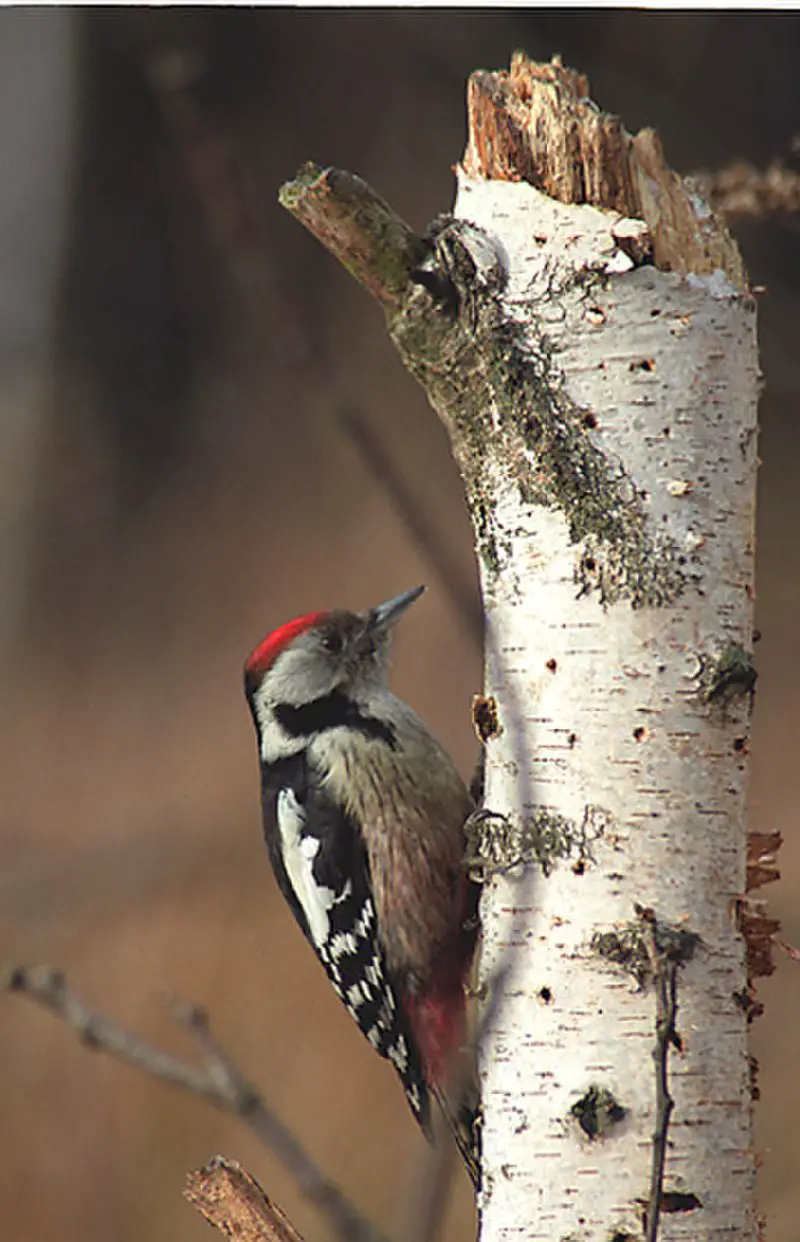
The Middle Spotted Woodpecker is a species of woodpecker native to Europe. It was formally described by the Swedish naturalist Carl Linnaeus in 1758 and given the binomial name Picus medius, with “medius” meaning intermediate – referring to its size compared to other woodpeckers.
They have black-and-white plumage with a distinctive red patch on their crowns, and are usually found around woodland areas where they feed on insects such as ants and beetles.
The males make loud drumming noises during mating season which can be heard for up to 500 meters away.
These birds generally live in tree cavities but will also nest inside old walls or buildings if available.
Conservation efforts are underway across Europe due to decreasing populations caused by habitat loss and fragmentation from human activity, making it an important species worth protecting.Scientific classification:
| Kingdom | Animalia |
| Phylum | Chordata |
| Class | Aves |
| Order | Piciformes |
| Family | Picidae |
| Genus | Dendrocoptes |
| Species | D. medius |
43. White-Backed Woodpecker
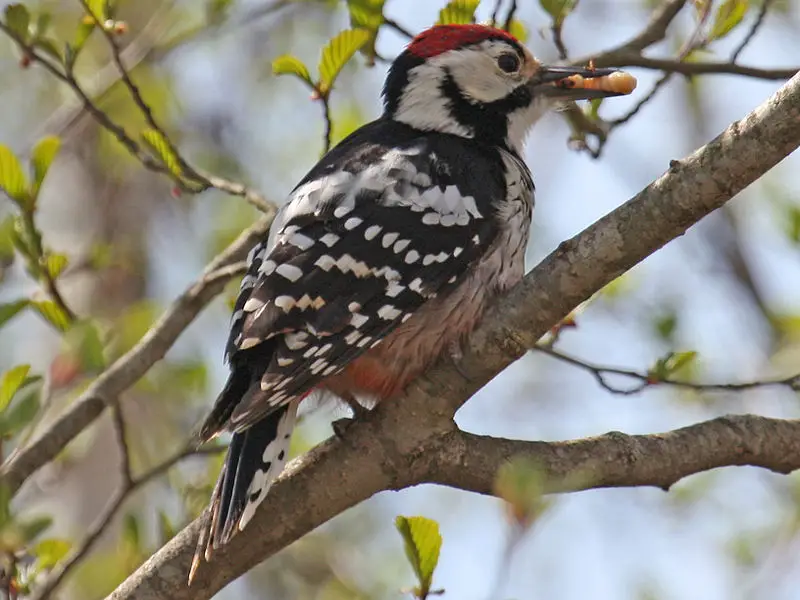
The White-backed Woodpecker is a beautiful bird that can be found in Eurasia. It has white plumage on its back, giving it its name.
Its head and wings are grey with black barring while its breast and belly have red speckles across them.
This species was first described by German naturalist Johann Matthäus Bechstein in 1802 who gave it the scientific binomial of Picus leucotos due to the white colouring along its back from the Greek words “leukos” meaning ‘white’ and “-nōtos” which means ‘backed’.
The type locality for this species is Silesia where these birds are still commonly seen today.Scientific classification:
| Kingdom | Animalia |
| Phylum | Chordata |
| Class | Aves |
| Order | Piciformes |
| Family | Picidae |
| Genus | Dendrocopos |
| Species | D. leucotos |
44. Yellow-Crowned Woodpecker
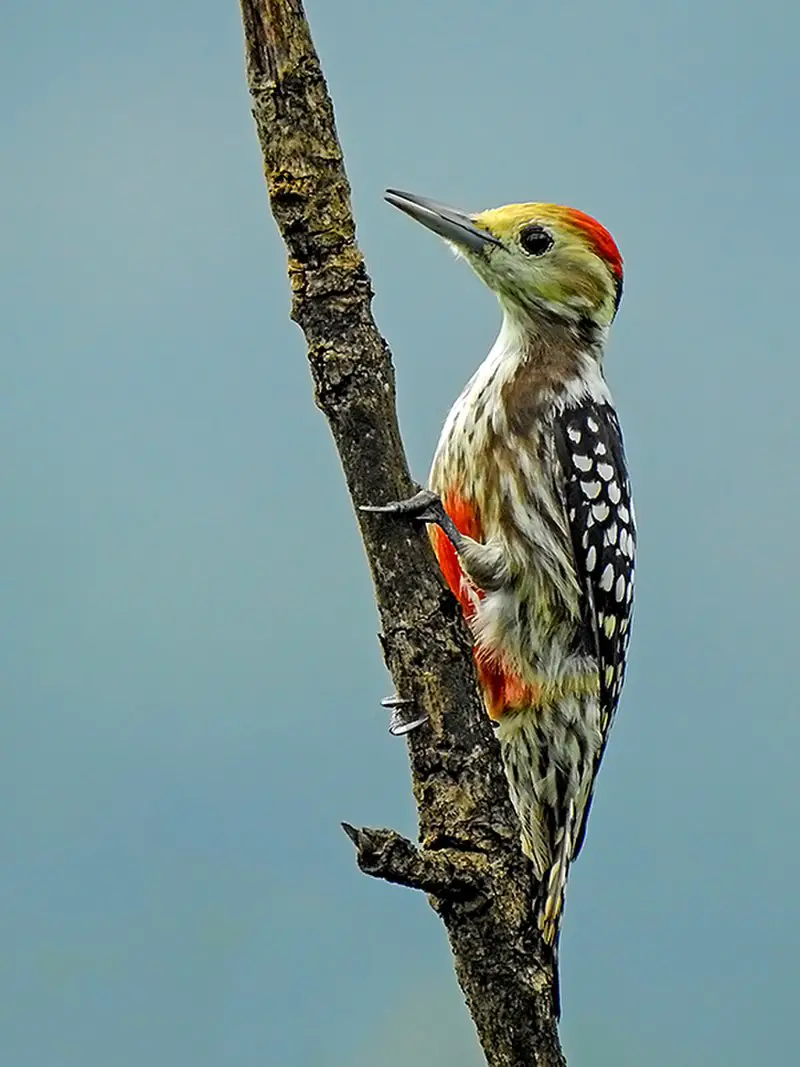
The Yellow-crowned woodpecker is a small, pied bird found in the Indian subcontinent. It was first described by English ornithologist John Latham in 1801 and is the only species within its genus Leiopicus.
This species has black upperparts with white stripes on its wings and yellow crowns along their heads and necks.
Its underparts are usually greyish or brownish with buffy streaks which help it to camouflage among tree branches as they feed mainly on insects like ants, beetles, bees etc that live inside trunks of trees.
They also eat fruits occasionally but mostly rely on insects for sustenance during breeding season when food availability increases significantly compared to other times of year due to insect activity increasing around this time period.Scientific classification:
| Kingdom | Animalia |
| Phylum | Chordata |
| Class | Aves |
| Order | Piciformes |
| Family | Picidae |
| Genus | Leiopicus Bonaparte, 1854 |
| Species | L. mahrattensis |
Also Featured In: Birds that Live in Rajasthan, Birds of Andhra Pradesh
45. Arabian Woodpecker
The Arabian woodpecker, also known as the Sarat Woodpecker, is a species of bird that resides in the Sarawat Mountains of Saudi Arabia and Yemen.
It’s unique to this region because it’s the only woodpecker that breeds on the Arabian Peninsula.
The American naturalist George Latimer Bates and Scottish zoologist Norman Boyd Kinnear were credited with its discovery when they described it and gave it scientific name: Dendrocoptes dorae in 1935.
This small bird has black plumage with white patches along its wings while its head has yellowish-orange feathers.
Its beak is short but strong enough for drilling into trees where they feed on insects like ants, beetles and termites found under bark or near dead branches.
They are also known to build their nests inside tree trunks by hollowing them out first before making their home there; thus helping promote healthier forest growth by creating space for new saplings to sprout from within these old hollowed logs.Scientific classification:
| Kingdom | Animalia |
| Phylum | Chordata |
| Class | Aves |
| Order | Piciformes |
| Family | Picidae |
| Genus | Dendrocoptes |
| Species | D. dorae |
46. Magellanic Woodpecker
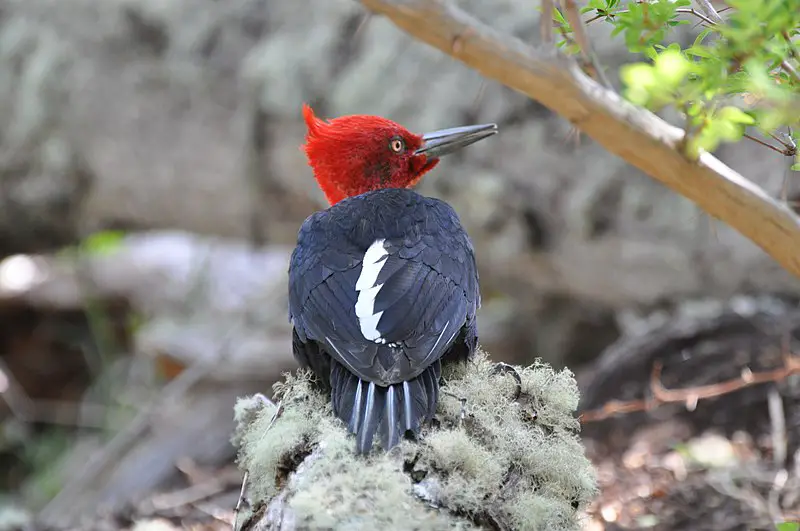
The Magellanic woodpecker is a large species of bird found in the southern regions of Chile and Argentina. It is part of the Campephilus genus, which includes iconic birds such as ivory-billed woodpeckers.
This species can grow to be up to 45 cm (18 inches) long, with males weighing an average of 320 grams (11 ounces). Its plumage consists mostly of black feathers on its head, wings and backside; it has white markings covering its belly area.
The most distinct feature about this bird is its red crest that runs from behind their bill down over their neck and shoulders – hence giving them their name ‘Magellanic’.
These beautiful creatures are known for making loud drumming noises as they search for food like beetles, ants or other insects in tree trunks or branches.
They inhabit dense forests areas where they can find plenty to eat while avoiding being preyed upon by predators.Scientific classification:
| Kingdom | Animalia |
| Phylum | Chordata |
| Class | Aves |
| Order | Piciformes |
| Family | Picidae |
| Genus | Campephilus |
| Species | C. magellanicus |
47. Bermuda Flicker
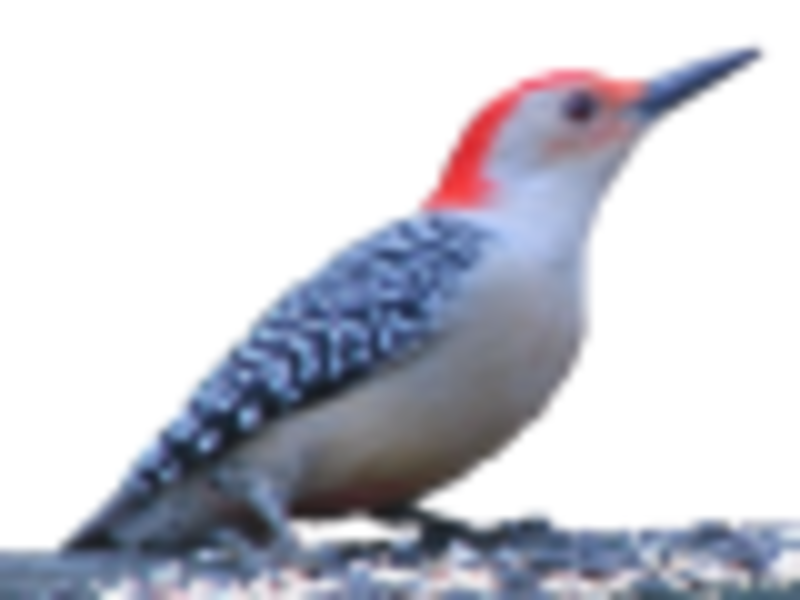
Bermuda Flicker is an extinct woodpecker of the genus Colaptes, which was only found in Bermuda. Its fossil remains date back to Late Pleistocene and Holocene epochs.
It may have been mentioned by explorer Captain John Smith from 17th century in one of his travel reports too. Storrs L. Olso unearthed most material related to this species during excavations of deposits from the late pleistocene age.
This bird had a unique brown plumage with white stripes on its wings, tail and head along with bright red patches near their eyes or bill area making it quite distinctive amongst other birds at that time period.Scientific classification:
| Kingdom | Animalia |
| Phylum | Chordata |
| Class | Aves |
| Order | Piciformes |
| Family | Picidae |
| Genus | Colaptes |
| Species | †C. oceanicus |
48. Smoky-Brown Woodpecker
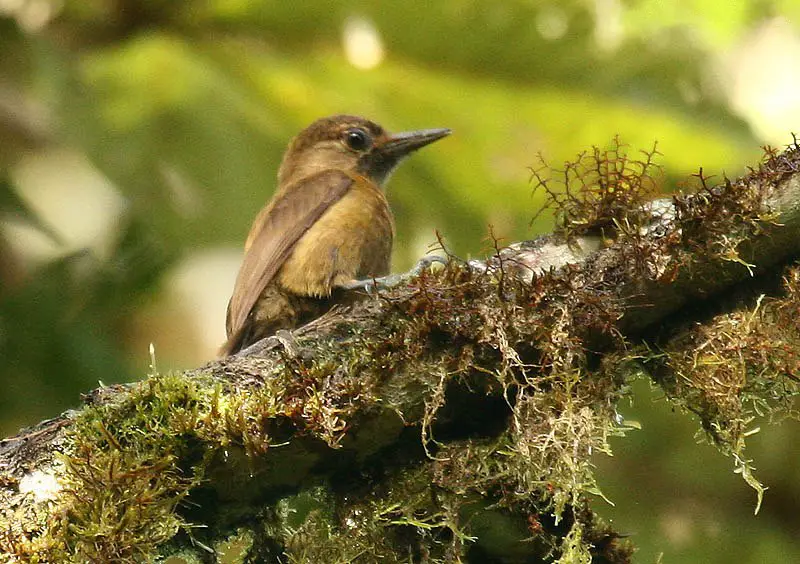
The smoky-brown woodpecker is a species of bird in the family Picidae, found throughout South and Central America.
It was first described by French naturalist Alcide d’Orbigny who observed individuals in Argentina’s Province of Corrientes.
This medium sized bird has black plumage on its head, wings and back with dark brown underparts. Its beak is yellowish white while its feet are greyish-black.
The male also features red patches on both sides of his neck which distinguish him from the female.
These birds feed mainly on insects but will eat some fruit too, digging holes in trees to extract their food source or hammering away at bark peels for larvae underneath it.
They can often be seen near open areas like forest edges or pastures where they nest between March and August each year usually laying two eggs per clutch that hatch after 14 days incubation period.Scientific classification:
| Kingdom | Animalia |
| Phylum | Chordata |
| Class | Aves |
| Order | Piciformes |
| Family | Picidae |
| Genus | Leuconotopicus |
| Species | L. fumigatus |